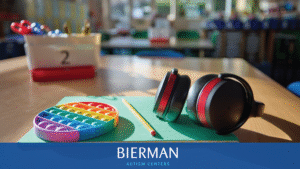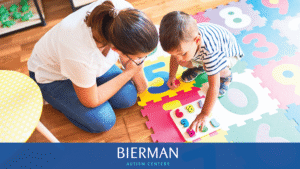If you are a parent or family member with an autistic child, it is very important that your family and friends understand the disorder and how to react to your child’s behavior. For some families, this might be the first time that they have knowingly met someone with this diagnosis. In order to ensure the best results for your child, educating your family and friends about autism spectrum disorder (ASD) will greatly improve your child’s development, as they would have the proper training not only at school or in therapy but at home as well. Here are some tips for talking about autism.
What is ASD?
Autism spectrum disorder (autism or Asperger’s) is a developmental disorder. It is characterized by problems with communication and social interaction and restricted or repetitive behaviors, interests, or activities. This disorder is usually found during your child’s early development, and it is persistent throughout their whole life; your child simply cannot “grow out of it.”
What are the symptoms?
It is important to note that autism is a spectrum, and not all autistic children will have of the same symptoms. Symptoms may show up differently in every child, and remember that no one is the same. When describing symptoms to someone, make sure to explain what these symptoms look like from your child’s perspective. For example:
Communication
- Lack of back-and-forth conversation. Typically, when asking someone their favorite color, they respond with an answer and will proceed to ask you a question. An autistic child might not want to share their interests with others (verbally or nonverbally). Children on the spectrum may struggle with interacting with these kinds of conversations.
- Lack of emotion. Children on the spectrum also may not share their emotions appropriately, oftentimes, you’ll notice that their emotions or facial expressions do not seem to match the situation or that they are more intense than what you would expect for a given situation.
- Poor eye contact. This varies by each child, but generally, these kids avoid eye contact and have difficulty keeping eye contact.
- Lack of gestures. Examples of this may be poor pointing, using someone else’s hand to reach something, unusual body language when conversing, etc.
- Lack of interest in peers. They might not even notice their peers around them; if they do, they could be actively avoiding them because they may not enjoy social attention or their peers may not share the same interests.
Behavior
- Restricted interests or repetitive play. Some kids may be interested in cars, but rather than drive their little cars around on a mat or using a car track, like a race car track, they line up their cars and want them in a very specific way. They may become hyper-focused on the part of an object or use an object in only one way. A common one is wheels, for example, spinning the wheel on a toy instead of playing with the toy as a whole.
- Inflexible routines. Oftentimes kids get used to doing things in a certain way at a certain time, and that routine becomes very strict. They also may have difficulty with transitions; if they enjoy one activity, they may not want to transition to another. Some kids require their routines to stay the same, from getting ready to school to eating the same foods and playing the same games. Any disruption or change in a regular routine may cause them to become upset.
- Scripting. If your child is watching the same cartoons, the same shows, the same movies, perhaps even the same clips of those shows or cartoons or movies, you may hear your child repeat the same things repeatedly.
- Sensory input. Your child might not like specific tastes, smells, and textures and can throw a tantrum when exposed. The opposite may occur, and they can lack sensory awareness. They may not have a normal pain perception – what you find painful, they may not.
What does ABA achieve?
Applied Behavior Analysis, or ABA, is based on scientific knowledge. The effectiveness has been demonstrated across multiple studies and is the number one evidence-based treatment for autism. ABA increases language and communication skills. We
work on getting the first sounds that kids are making all the way up to more complex sentences and social skills. We also work on finding different modes of communication, so autistic children have a mode to express their wants and needs. ABA tries to decrease challenging behaviors that are occurring and teaches new skills to be used in place of those behaviors.
To understand your child’s behavior, you always want to find out why they’re engaging in a specific behavior. Instead of saying, “it’s because they have autism,” find out why they are acting this way. What happened before and after this behavior is how we can treat and prevent it in the future!
In ABA Therapy, we use positive reinforcement whenever the behavior we want to see occurs. Positive reinforcement in the interventions helps your child understand that this is the behavior we want to see and want you to do it again. It is important that we teach what they should be doing instead of what they shouldn’t be doing.
How to encourage friends and family to interact with your child
- Take the lead. Show them how you want them to interact with your child. Give them positive alternatives. Help them know what they’re allowed to do when facing challenging behavior from your child.
- Encourage them to play and interact with your child. Describe what they like to play with and how they can become involved with your child.
- Teach them to narrate their actions. Every time you’re narrating what’s going on, you’re teaching them language. You’re continuing to give your child examples of the appropriate use of language. This is important to do if your child has limited vocal abilities.
- Discuss what your target objectives are for your child. Share the short-term goals you and your ABA team have come up with. Specify what it is about ABA that is important to you, why you’re using it, and what you’re trying to get out of it. Highlight your child’s strengths and progress with them. Celebrate the goals your child has achieved! Open up about the things that are challenging and difficult. If your family and friends understand your struggles, they can help you overcome them by helping your child.
Your child will greatly appreciate and benefit from an entire home support system. We hope that you will see improvements and positive outcomes by inviting your friends and family into this journey. Every child on the spectrum is unique and should be treated as such. Please tailor our advice to your child’s needs and preferences for the ultimate results.
Note: This blog post is based on a Bierman Caregiver Webinar.[/vc_column_text][/vc_column][/vc_row]JTNDc3R5bGUlM0UlMEElMjAlMjNfZm9ybV8xNl8lMjAlN0IlMjBmb250LXNpemUlM0ExNHB4JTNCJTIwbGluZS1oZWlnaHQlM0ExLjYlM0IlMjBmb250LWZhbWlseSUzQWFyaWFsJTJDJTIwaGVsdmV0aWNhJTJDJTIwc2Fucy1zZXJpZiUzQiUyMG1hcmdpbiUzQTAlM0IlMjAlN0QlMEElMjAlMjNfZm9ybV8xNl8lMjAlMkElMjAlN0IlMjBvdXRsaW5lJTNBMCUzQiUyMCU3RCUwQSUyMC5fZm9ybV9oaWRlJTIwJTdCJTIwZGlzcGxheSUzQW5vbmUlM0IlMjB2aXNpYmlsaXR5JTNBaGlkZGVuJTNCJTIwJTdEJTBBJTIwLl9mb3JtX3Nob3clMjAlN0IlMjBkaXNwbGF5JTNBYmxvY2slM0IlMjB2aXNpYmlsaXR5JTNBdmlzaWJsZSUzQiUyMCU3RCUwQSUyMCUyM19mb3JtXzE2Xy5fZm9ybS10b3AlMjAlN0IlMjB0b3AlM0EwJTNCJTIwJTdEJTBBJTIwJTIzX2Zvcm1fMTZfLl9mb3JtLWJvdHRvbSUyMCU3QiUyMGJvdHRvbSUzQTAlM0IlMjAlN0QlMEElMjAlMjNfZm9ybV8xNl8uX2Zvcm0tbGVmdCUyMCU3QiUyMGxlZnQlM0EwJTNCJTIwJTdEJTBBJTIwJTIzX2Zvcm1fMTZfLl9mb3JtLXJpZ2h0JTIwJTdCJTIwcmlnaHQlM0EwJTNCJTIwJTdEJTBBJTIwJTIzX2Zvcm1fMTZfJTIwaW5wdXQlNUJ0eXBlJTNEJTIydGV4dCUyMiU1RCUyQyUyM19mb3JtXzE2XyUyMGlucHV0JTVCdHlwZSUzRCUyMnRlbCUyMiU1RCUyQyUyM19mb3JtXzE2XyUyMGlucHV0JTVCdHlwZSUzRCUyMmRhdGUlMjIlNUQlMkMlMjNfZm9ybV8xNl8lMjB0ZXh0YXJlYSUyMCU3QiUyMHBhZGRpbmclM0E2cHglM0IlMjBoZWlnaHQlM0FhdXRvJTNCJTIwYm9yZGVyJTNBJTIzOTc5Nzk3JTIwMXB4JTIwc29saWQlM0IlMjBib3JkZXItcmFkaXVzJTNBNHB4JTNCJTIwY29sb3IlM0ElMjMwMDAlMjAlMjFpbXBvcnRhbnQlM0IlMjBmb250LXNpemUlM0ExNHB4JTNCJTIwLXdlYmtpdC1ib3gtc2l6aW5nJTNBYm9yZGVyLWJveCUzQiUyMC1tb3otYm94LXNpemluZyUzQWJvcmRlci1ib3glM0IlMjBib3gtc2l6aW5nJTNBYm9yZGVyLWJveCUzQiUyMCU3RCUwQSUyMCUyM19mb3JtXzE2XyUyMHRleHRhcmVhJTIwJTdCJTIwcmVzaXplJTNBbm9uZSUzQiUyMCU3RCUwQSUyMCUyM19mb3JtXzE2XyUyMC5fc3VibWl0JTIwJTdCJTIwLXdlYmtpdC1hcHBlYXJhbmNlJTNBbm9uZSUzQiUyMGN1cnNvciUzQXBvaW50ZXIlM0IlMjBmb250LWZhbWlseSUzQWFyaWFsJTJDJTIwc2Fucy1zZXJpZiUzQiUyMGZvbnQtc2l6ZSUzQTE0cHglM0IlMjB0ZXh0LWFsaWduJTNBY2VudGVyJTNCJTIwYmFja2dyb3VuZCUzQSUyMzE4NDc5MiUyMCUyMWltcG9ydGFudCUzQiUyMGJvcmRlciUzQTAlMjAlMjFpbXBvcnRhbnQlM0IlMjAtbW96LWJvcmRlci1yYWRpdXMlM0E0cHglMjAlMjFpbXBvcnRhbnQlM0IlMjAtd2Via2l0LWJvcmRlci1yYWRpdXMlM0E0cHglMjAlMjFpbXBvcnRhbnQlM0IlMjBib3JkZXItcmFkaXVzJTNBNHB4JTIwJTIxaW1wb3J0YW50JTNCJTIwY29sb3IlM0ElMjNmN2QwNDQlMjAlMjFpbXBvcnRhbnQlM0IlMjBwYWRkaW5nJTNBMTBweCUyMCUyMWltcG9ydGFudCUzQiUyMCU3RCUwQSUyMCUyM19mb3JtXzE2XyUyMC5fY2xvc2UtaWNvbiUyMCU3QiUyMGN1cnNvciUzQXBvaW50ZXIlM0IlMjBiYWNrZ3JvdW5kLWltYWdlJTNBdXJsJTI4JTI3aHR0cHMlM0ElMkYlMkZkMjI2YWo0YW8xdDYxcS5jbG91ZGZyb250Lm5ldCUyRmVzZmt5amgxdV9mb3Jtcy1jbG9zZS1kYXJrLnBuZyUyNyUyOSUzQiUyMGJhY2tncm91bmQtcmVwZWF0JTNBbm8tcmVwZWF0JTNCJTIwYmFja2dyb3VuZC1zaXplJTNBMTQuMnB4JTIwMTQuMnB4JTNCJTIwcG9zaXRpb24lM0FhYnNvbHV0ZSUzQiUyMGRpc3BsYXklM0FibG9jayUzQiUyMHRvcCUzQTExcHglM0IlMjByaWdodCUzQTlweCUzQiUyMG92ZXJmbG93JTNBaGlkZGVuJTNCJTIwd2lkdGglM0ExNi4ycHglM0IlMjBoZWlnaHQlM0ExNi4ycHglM0IlMjAlN0QlMEElMjAlMjNfZm9ybV8xNl8lMjAuX2Nsb3NlLWljb24lM0FiZWZvcmUlMjAlN0IlMjBwb3NpdGlvbiUzQXJlbGF0aXZlJTNCJTIwJTdEJTBBJTIwJTIzX2Zvcm1fMTZfJTIwLl9mb3JtLWJvZHklMjAlN0IlMjBtYXJnaW4tYm90dG9tJTNBMzBweCUzQiUyMCU3RCUwQSUyMCUyM19mb3JtXzE2XyUyMC5fZm9ybS1pbWFnZS1sZWZ0JTIwJTdCJTIwd2lkdGglM0ExNTBweCUzQiUyMGZsb2F0JTNBbGVmdCUzQiUyMCU3RCUwQSUyMCUyM19mb3JtXzE2XyUyMC5fZm9ybS1jb250ZW50LXJpZ2h0JTIwJTdCJTIwbWFyZ2luLWxlZnQlM0ExNjRweCUzQiUyMCU3RCUwQSUyMCUyM19mb3JtXzE2XyUyMC5fZm9ybS1icmFuZGluZyUyMCU3QiUyMGNvbG9yJTNBJTIzZmZmJTNCJTIwZm9udC1zaXplJTNBMTBweCUzQiUyMGNsZWFyJTNBYm90aCUzQiUyMHRleHQtYWxpZ24lM0FsZWZ0JTNCJTIwbWFyZ2luLXRvcCUzQTMwcHglM0IlMjBmb250LXdlaWdodCUzQTEwMCUzQiUyMCU3RCUwQSUyMCUyM19mb3JtXzE2XyUyMC5fZm9ybS1icmFuZGluZyUyMC5fbG9nbyUyMCU3QiUyMGRpc3BsYXklM0FibG9jayUzQiUyMHdpZHRoJTNBMTMwcHglM0IlMjBoZWlnaHQlM0ExNHB4JTNCJTIwbWFyZ2luLXRvcCUzQTZweCUzQiUyMGJhY2tncm91bmQtaW1hZ2UlM0F1cmwlMjglMjdodHRwcyUzQSUyRiUyRmQyMjZhajRhbzF0NjFxLmNsb3VkZnJvbnQubmV0JTJGaGg5dWpxZ3Y1X2FjbG9nb19saS5wbmclMjclMjklM0IlMjBiYWNrZ3JvdW5kLXNpemUlM0ExMzBweCUyMGF1dG8lM0IlMjBiYWNrZ3JvdW5kLXJlcGVhdCUzQW5vLXJlcGVhdCUzQiUyMCU3RCUwQSUyMCUyM19mb3JtXzE2XyUyMC5mb3JtLXNyLW9ubHklMjAlN0IlMjBwb3NpdGlvbiUzQWFic29sdXRlJTNCJTIwd2lkdGglM0ExcHglM0IlMjBoZWlnaHQlM0ExcHglM0IlMjBwYWRkaW5nJTNBMCUzQiUyMG1hcmdpbiUzQS0xcHglM0IlMjBvdmVyZmxvdyUzQWhpZGRlbiUzQiUyMGNsaXAlM0FyZWN0JTI4MCUyQyUyMDAlMkMlMjAwJTJDJTIwMCUyOSUzQiUyMGJvcmRlciUzQTAlM0IlMjAlN0QlMEElMjAlMjNfZm9ybV8xNl8lMjAuX2Zvcm0tbGFiZWwlMkMlMjNfZm9ybV8xNl8lMjAuX2Zvcm1fZWxlbWVudCUyMC5fZm9ybS1sYWJlbCUyMCU3QiUyMGZvbnQtd2VpZ2h0JTNBYm9sZCUzQiUyMG1hcmdpbi1ib3R0b20lM0E1cHglM0IlMjBkaXNwbGF5JTNBYmxvY2slM0IlMjAlN0QlMEElMjAlMjNfZm9ybV8xNl8uX2RhcmslMjAuX2Zvcm0tYnJhbmRpbmclMjAlN0IlMjBjb2xvciUzQSUyMzMzMyUzQiUyMCU3RCUwQSUyMCUyM19mb3JtXzE2Xy5fZGFyayUyMC5fZm9ybS1icmFuZGluZyUyMC5fbG9nbyUyMCU3QiUyMGJhY2tncm91bmQtaW1hZ2UlM0F1cmwlMjglMjdodHRwcyUzQSUyRiUyRmQyMjZhajRhbzF0NjFxLmNsb3VkZnJvbnQubmV0JTJGamZ0cTJjOHNfYWNsb2dvX2RrLnBuZyUyNyUyOSUzQiUyMCU3RCUwQSUyMCUyM19mb3JtXzE2XyUyMC5fZm9ybV9lbGVtZW50JTIwJTdCJTIwcG9zaXRpb24lM0FyZWxhdGl2ZSUzQiUyMG1hcmdpbi1ib3R0b20lM0ExMHB4JTNCJTIwZm9udC1zaXplJTNBMCUzQiUyMG1heC13aWR0aCUzQTEwMCUyNSUzQiUyMCU3RCUwQSUyMCUyM19mb3JtXzE2XyUyMC5fZm9ybV9lbGVtZW50JTIwJTJBJTIwJTdCJTIwZm9udC1zaXplJTNBMTRweCUzQiUyMCU3RCUwQSUyMCUyM19mb3JtXzE2XyUyMC5fZm9ybV9lbGVtZW50Ll9jbGVhciUyMCU3QiUyMGNsZWFyJTNBYm90aCUzQiUyMHdpZHRoJTNBMTAwJTI1JTNCJTIwZmxvYXQlM0Fub25lJTNCJTIwJTdEJTBBJTIwJTIzX2Zvcm1fMTZfJTIwLl9mb3JtX2VsZW1lbnQuX2NsZWFyJTNBYWZ0ZXIlMjAlN0IlMjBjbGVhciUzQWxlZnQlM0IlMjAlN0QlMEElMjAlMjNfZm9ybV8xNl8lMjAuX2Zvcm1fZWxlbWVudCUyMGlucHV0JTVCdHlwZSUzRCUyMnRleHQlMjIlNUQlMkMlMjNfZm9ybV8xNl8lMjAuX2Zvcm1fZWxlbWVudCUyMGlucHV0JTVCdHlwZSUzRCUyMmRhdGUlMjIlNUQlMkMlMjNfZm9ybV8xNl8lMjAuX2Zvcm1fZWxlbWVudCUyMHNlbGVjdCUyQyUyM19mb3JtXzE2XyUyMC5fZm9ybV9lbGVtZW50JTIwdGV4dGFyZWElM0Fub3QlMjguZy1yZWNhcHRjaGEtcmVzcG9uc2UlMjklMjAlN0IlMjBkaXNwbGF5JTNBYmxvY2slM0IlMjB3aWR0aCUzQTEwMCUyNSUzQiUyMC13ZWJraXQtYm94LXNpemluZyUzQWJvcmRlci1ib3glM0IlMjAtbW96LWJveC1zaXppbmclM0Fib3JkZXItYm94JTNCJTIwYm94LXNpemluZyUzQWJvcmRlci1ib3glM0IlMjBmb250LWZhbWlseSUzQWluaGVyaXQlM0IlMjAlN0QlMEElMjAlMjNfZm9ybV8xNl8lMjAuX2ZpZWxkLXdyYXBwZXIlMjAlN0IlMjBwb3NpdGlvbiUzQXJlbGF0aXZlJTNCJTIwJTdEJTBBJTIwJTIzX2Zvcm1fMTZfJTIwLl9pbmxpbmUtc3R5bGUlMjAlN0IlMjBmbG9hdCUzQWxlZnQlM0IlMjAlN0QlMEElMjAlMjNfZm9ybV8xNl8lMjAuX2lubGluZS1zdHlsZSUyMGlucHV0JTVCdHlwZSUzRCUyMnRleHQlMjIlNUQlMjAlN0IlMjB3aWR0aCUzQTE1MHB4JTNCJTIwJTdEJTBBJTIwJTIzX2Zvcm1fMTZfJTIwLl9pbmxpbmUtc3R5bGUlM0Fub3QlMjguX2NsZWFyJTI5JTIwJTJCJTIwLl9pbmxpbmUtc3R5bGUlM0Fub3QlMjguX2NsZWFyJTI5JTIwJTdCJTIwbWFyZ2luLWxlZnQlM0EyMHB4JTNCJTIwJTdEJTBBJTIwJTIzX2Zvcm1fMTZfJTIwLl9mb3JtX2VsZW1lbnQlMjBpbWcuX2Zvcm0taW1hZ2UlMjAlN0IlMjBtYXgtd2lkdGglM0ExMDAlMjUlM0IlMjAlN0QlMEElMjAlMjNfZm9ybV8xNl8lMjAuX2Zvcm1fZWxlbWVudCUyMC5fZm9ybS1maWVsZHNldCUyMCU3QiUyMGJvcmRlciUzQTAlM0IlMjBwYWRkaW5nJTNBMC4wMWVtJTIwMCUyMDAlMjAwJTNCJTIwbWFyZ2luJTNBMCUzQiUyMG1pbi13aWR0aCUzQTAlM0IlMjAlN0QlMEElMjAlMjNfZm9ybV8xNl8lMjAuX2NsZWFyLWVsZW1lbnQlMjAlN0IlMjBjbGVhciUzQWxlZnQlM0IlMjAlN0QlMEElMjAlMjNfZm9ybV8xNl8lMjAuX2Z1bGxfd2lkdGglMjAlN0IlMjB3aWR0aCUzQTEwMCUyNSUzQiUyMCU3RCUwQSUyMCUyM19mb3JtXzE2XyUyMC5fZm9ybV9mdWxsX2ZpZWxkJTIwJTdCJTIwZGlzcGxheSUzQWJsb2NrJTNCJTIwd2lkdGglM0ExMDAlMjUlM0IlMjBtYXJnaW4tYm90dG9tJTNBMTBweCUzQiUyMCU3RCUwQSUyMCUyM19mb3JtXzE2XyUyMGlucHV0JTVCdHlwZSUzRCUyMnRleHQlMjIlNUQuX2hhc19lcnJvciUyQyUyM19mb3JtXzE2XyUyMHRleHRhcmVhLl9oYXNfZXJyb3IlMjAlN0IlMjBib3JkZXIlM0ElMjNmMzdjN2IlMjAxcHglMjBzb2xpZCUzQiUyMCU3RCUwQSUyMCUyM19mb3JtXzE2XyUyMGlucHV0JTVCdHlwZSUzRCUyMmNoZWNrYm94JTIyJTVELl9oYXNfZXJyb3IlMjAlN0IlMjBvdXRsaW5lJTNBJTIzZjM3YzdiJTIwMXB4JTIwc29saWQlM0IlMjAlN0QlMEElMjAlMjNfZm9ybV8xNl8lMjAuX2Vycm9yJTIwJTdCJTIwZGlzcGxheSUzQWJsb2NrJTNCJTIwcG9zaXRpb24lM0FhYnNvbHV0ZSUzQiUyMGZvbnQtc2l6ZSUzQTE0cHglM0IlMjB6LWluZGV4JTNBMTAwMDAwMDElM0IlMjAlN0QlMEElMjAlMjNfZm9ybV8xNl8lMjAuX2Vycm9yLl9hYm92ZSUyMCU3QiUyMHBhZGRpbmctYm90dG9tJTNBNHB4JTNCJTIwYm90dG9tJTNBMzlweCUzQiUyMHJpZ2h0JTNBMCUzQiUyMCU3RCUwQSUyMCUyM19mb3JtXzE2XyUyMC5fZXJyb3IuX2JlbG93JTIwJTdCJTIwcGFkZGluZy10b3AlM0E0cHglM0IlMjB0b3AlM0ExMDAlMjUlM0IlMjByaWdodCUzQTAlM0IlMjAlN0QlMEElMjAlMjNfZm9ybV8xNl8lMjAuX2Vycm9yLl9hYm92ZSUyMC5fZXJyb3ItYXJyb3clMjAlN0IlMjBib3R0b20lM0EwJTNCJTIwcmlnaHQlM0ExNXB4JTNCJTIwYm9yZGVyLWxlZnQlM0E1cHglMjBzb2xpZCUyMHRyYW5zcGFyZW50JTNCJTIwYm9yZGVyLXJpZ2h0JTNBNXB4JTIwc29saWQlMjB0cmFuc3BhcmVudCUzQiUyMGJvcmRlci10b3AlM0E1cHglMjBzb2xpZCUyMCUyM2YzN2M3YiUzQiUyMCU3RCUwQSUyMCUyM19mb3JtXzE2XyUyMC5fZXJyb3IuX2JlbG93JTIwLl9lcnJvci1hcnJvdyUyMCU3QiUyMHRvcCUzQTAlM0IlMjByaWdodCUzQTE1cHglM0IlMjBib3JkZXItbGVmdCUzQTVweCUyMHNvbGlkJTIwdHJhbnNwYXJlbnQlM0IlMjBib3JkZXItcmlnaHQlM0E1cHglMjBzb2xpZCUyMHRyYW5zcGFyZW50JTNCJTIwYm9yZGVyLWJvdHRvbSUzQTVweCUyMHNvbGlkJTIwJTIzZjM3YzdiJTNCJTIwJTdEJTBBJTIwJTIzX2Zvcm1fMTZfJTIwLl9lcnJvci1pbm5lciUyMCU3QiUyMHBhZGRpbmclM0E4cHglMjAxMnB4JTNCJTIwYmFja2dyb3VuZC1jb2xvciUzQSUyM2YzN2M3YiUzQiUyMGZvbnQtc2l6ZSUzQTE0cHglM0IlMjBmb250LWZhbWlseSUzQWFyaWFsJTJDJTIwc2Fucy1zZXJpZiUzQiUyMGNvbG9yJTNBJTIzZmZmJTNCJTIwdGV4dC1hbGlnbiUzQWNlbnRlciUzQiUyMHRleHQtZGVjb3JhdGlvbiUzQW5vbmUlM0IlMjAtd2Via2l0LWJvcmRlci1yYWRpdXMlM0E0cHglM0IlMjAtbW96LWJvcmRlci1yYWRpdXMlM0E0cHglM0IlMjBib3JkZXItcmFkaXVzJTNBNHB4JTNCJTIwJTdEJTBBJTIwJTIzX2Zvcm1fMTZfJTIwLl9lcnJvci1pbm5lci5fZm9ybV9lcnJvciUyMCU3QiUyMG1hcmdpbi1ib3R0b20lM0E1cHglM0IlMjB0ZXh0LWFsaWduJTNBbGVmdCUzQiUyMCU3RCUwQSUyMCUyM19mb3JtXzE2XyUyMC5fYnV0dG9uLXdyYXBwZXIlMjAuX2Vycm9yLWlubmVyLl9mb3JtX2Vycm9yJTIwJTdCJTIwcG9zaXRpb24lM0FzdGF0aWMlM0IlMjAlN0QlMEElMjAlMjNfZm9ybV8xNl8lMjAuX2Vycm9yLWlubmVyLl9ub19hcnJvdyUyMCU3QiUyMG1hcmdpbi1ib3R0b20lM0ExMHB4JTNCJTIwJTdEJTBBJTIwJTIzX2Zvcm1fMTZfJTIwLl9lcnJvci1hcnJvdyUyMCU3QiUyMHBvc2l0aW9uJTNBYWJzb2x1dGUlM0IlMjB3aWR0aCUzQTAlM0IlMjBoZWlnaHQlM0EwJTNCJTIwJTdEJTBBJTIwJTIzX2Zvcm1fMTZfJTIwLl9lcnJvci1odG1sJTIwJTdCJTIwbWFyZ2luLWJvdHRvbSUzQTEwcHglM0IlMjAlN0QlMEElMjAucGlrYS1zaW5nbGUlMjAlN0IlMjB6LWluZGV4JTNBMTAwMDAwMDElMjAlMjFpbXBvcnRhbnQlM0IlMjAlN0QlMEElMjAlMjNfZm9ybV8xNl8lMjBpbnB1dCU1QnR5cGUlM0QlMjJ0ZXh0JTIyJTVELmRhdGV0aW1lX2RhdGUlMjAlN0IlMjB3aWR0aCUzQTY5JTI1JTNCJTIwZGlzcGxheSUzQWlubGluZSUzQiUyMCU3RCUwQSUyMCUyM19mb3JtXzE2XyUyMHNlbGVjdC5kYXRldGltZV90aW1lJTIwJTdCJTIwd2lkdGglM0EyOSUyNSUzQiUyMGRpc3BsYXklM0FpbmxpbmUlM0IlMjBoZWlnaHQlM0EzMnB4JTNCJTIwJTdEJTBBJTIwJTIzX2Zvcm1fMTZfJTIwaW5wdXQlNUJ0eXBlJTNEJTIyZGF0ZSUyMiU1RC5kYXRldGltZV9kYXRlJTIwJTdCJTIwd2lkdGglM0E2OSUyNSUzQiUyMGRpc3BsYXklM0FpbmxpbmUtZmxleCUzQiUyMCU3RCUwQSUyMCUyM19mb3JtXzE2XyUyMGlucHV0JTVCdHlwZSUzRCUyMnRpbWUlMjIlNUQuZGF0ZXRpbWVfdGltZSUyMCU3QiUyMHdpZHRoJTNBMjklMjUlM0IlMjBkaXNwbGF5JTNBaW5saW5lLWZsZXglM0IlMjAlN0QlMEElMjAlNDBtZWRpYSUyMGFsbCUyMGFuZCUyMCUyOG1pbi13aWR0aCUzQTMyMHB4JTI5JTIwYW5kJTIwJTI4bWF4LXdpZHRoJTNBNjY3cHglMjklMjAlN0IlMjAlM0ElM0Etd2Via2l0LXNjcm9sbGJhciUyMCU3QiUyMGRpc3BsYXklM0Fub25lJTNCJTIwJTdEJTBBJTIwJTIzX2Zvcm1fMTZfJTIwJTdCJTIwbWFyZ2luJTNBMCUzQiUyMHdpZHRoJTNBMTAwJTI1JTNCJTIwbWluLXdpZHRoJTNBMTAwJTI1JTNCJTIwbWF4LXdpZHRoJTNBMTAwJTI1JTNCJTIwYm94LXNpemluZyUzQWJvcmRlci1ib3glM0IlMjAlN0QlMEElMjAlMjNfZm9ybV8xNl8lMjAlMkElMjAlN0IlMjAtd2Via2l0LWJveC1zaXppbmclM0Fib3JkZXItYm94JTNCJTIwLW1vei1ib3gtc2l6aW5nJTNBYm9yZGVyLWJveCUzQiUyMGJveC1zaXppbmclM0Fib3JkZXItYm94JTNCJTIwZm9udC1zaXplJTNBMWVtJTNCJTIwJTdEJTBBJTIwJTIzX2Zvcm1fMTZfJTIwLl9mb3JtLWNvbnRlbnQlMjAlN0IlMjBtYXJnaW4lM0EwJTNCJTIwd2lkdGglM0ExMDAlMjUlM0IlMjAlN0QlMEElMjAlMjNfZm9ybV8xNl8lMjAuX2Zvcm0taW5uZXIlMjAlN0IlMjBkaXNwbGF5JTNBYmxvY2slM0IlMjBtaW4td2lkdGglM0ExMDAlMjUlM0IlMjAlN0QlMEElMjAlMjNfZm9ybV8xNl8lMjAuX2Zvcm0tdGl0bGUlMkMlMjNfZm9ybV8xNl8lMjAuX2lubGluZS1zdHlsZSUyMCU3QiUyMG1hcmdpbi10b3AlM0EwJTNCJTIwbWFyZ2luLXJpZ2h0JTNBMCUzQiUyMG1hcmdpbi1sZWZ0JTNBMCUzQiUyMCU3RCUwQSUyMCUyM19mb3JtXzE2XyUyMC5fZm9ybS10aXRsZSUyMCU3QiUyMGZvbnQtc2l6ZSUzQTEuMmVtJTNCJTIwJTdEJTBBJTIwJTIzX2Zvcm1fMTZfJTIwLl9mb3JtX2VsZW1lbnQlMjAlN0IlMjBtYXJnaW4lM0EwJTIwMCUyMDIwcHglM0IlMjBwYWRkaW5nJTNBMCUzQiUyMHdpZHRoJTNBMTAwJTI1JTNCJTIwJTdEJTBBJTIwJTIzX2Zvcm1fMTZfJTIwLl9mb3JtLWVsZW1lbnQlMkMlMjNfZm9ybV8xNl8lMjAuX2lubGluZS1zdHlsZSUyQyUyM19mb3JtXzE2XyUyMGlucHV0JTVCdHlwZSUzRCUyMnRleHQlMjIlNUQlMkMlMjNfZm9ybV8xNl8lMjBsYWJlbCUyQyUyM19mb3JtXzE2XyUyMHAlMkMlMjNfZm9ybV8xNl8lMjB0ZXh0YXJlYSUzQW5vdCUyOC5nLXJlY2FwdGNoYS1yZXNwb25zZSUyOSUyMCU3QiUyMGZsb2F0JTNBbm9uZSUzQiUyMGRpc3BsYXklM0FibG9jayUzQiUyMHdpZHRoJTNBMTAwJTI1JTNCJTIwJTdEJTBBJTIwJTIzX2Zvcm1fMTZfJTIwLl9yb3cuX2NoZWNrYm94LXJhZGlvJTIwbGFiZWwlMjAlN0IlMjBkaXNwbGF5JTNBaW5saW5lJTNCJTIwJTdEJTBBJTIwJTIzX2Zvcm1fMTZfJTIwLl9yb3clMkMlMjNfZm9ybV8xNl8lMjBwJTJDJTIzX2Zvcm1fMTZfJTIwbGFiZWwlMjAlN0IlMjBtYXJnaW4tYm90dG9tJTNBMC43ZW0lM0IlMjB3aWR0aCUzQTEwMCUyNSUzQiUyMCU3RCUwQSUyMCUyM19mb3JtXzE2XyUyMC5fcm93JTIwaW5wdXQlNUJ0eXBlJTNEJTIyY2hlY2tib3glMjIlNUQlMkMlMjNfZm9ybV8xNl8lMjAuX3JvdyUyMGlucHV0JTVCdHlwZSUzRCUyMnJhZGlvJTIyJTVEJTIwJTdCJTIwbWFyZ2luJTNBMCUyMCUyMWltcG9ydGFudCUzQiUyMHZlcnRpY2FsLWFsaWduJTNBbWlkZGxlJTIwJTIxaW1wb3J0YW50JTNCJTIwJTdEJTBBJTIwJTIzX2Zvcm1fMTZfJTIwLl9yb3clMjBpbnB1dCU1QnR5cGUlM0QlMjJjaGVja2JveCUyMiU1RCUyMCUyQiUyMHNwYW4lMjBsYWJlbCUyMCU3QiUyMGRpc3BsYXklM0FpbmxpbmUlM0IlMjAlN0QlMEElMjAlMjNfZm9ybV8xNl8lMjAuX3JvdyUyMHNwYW4lMjBsYWJlbCUyMCU3QiUyMG1hcmdpbiUzQTAlMjAlMjFpbXBvcnRhbnQlM0IlMjB3aWR0aCUzQWluaXRpYWwlMjAlMjFpbXBvcnRhbnQlM0IlMjB2ZXJ0aWNhbC1hbGlnbiUzQW1pZGRsZSUyMCUyMWltcG9ydGFudCUzQiUyMCU3RCUwQSUyMCUyM19mb3JtXzE2XyUyMC5fZm9ybS1pbWFnZSUyMCU3QiUyMG1heC13aWR0aCUzQTEwMCUyNSUzQiUyMGhlaWdodCUzQWF1dG8lMjAlMjFpbXBvcnRhbnQlM0IlMjAlN0QlMEElMjAlMjNfZm9ybV8xNl8lMjBpbnB1dCU1QnR5cGUlM0QlMjJ0ZXh0JTIyJTVEJTIwJTdCJTIwcGFkZGluZy1sZWZ0JTNBMTBweCUzQiUyMHBhZGRpbmctcmlnaHQlM0ExMHB4JTNCJTIwZm9udC1zaXplJTNBMTZweCUzQiUyMGxpbmUtaGVpZ2h0JTNBMS4zZW0lM0IlMjAtd2Via2l0LWFwcGVhcmFuY2UlM0Fub25lJTNCJTIwJTdEJTBBJTIwJTIzX2Zvcm1fMTZfJTIwaW5wdXQlNUJ0eXBlJTNEJTIycmFkaW8lMjIlNUQlMkMlMjNfZm9ybV8xNl8lMjBpbnB1dCU1QnR5cGUlM0QlMjJjaGVja2JveCUyMiU1RCUyMCU3QiUyMGRpc3BsYXklM0FpbmxpbmUtYmxvY2slM0IlMjB3aWR0aCUzQTEuM2VtJTNCJTIwaGVpZ2h0JTNBMS4zZW0lM0IlMjBmb250LXNpemUlM0ExZW0lM0IlMjBtYXJnaW4lM0EwJTIwMC4zZW0lMjAwJTIwMCUzQiUyMHZlcnRpY2FsLWFsaWduJTNBYmFzZWxpbmUlM0IlMjAlN0QlMEElMjAlMjNfZm9ybV8xNl8lMjBidXR0b24lNUJ0eXBlJTNEJTIyc3VibWl0JTIyJTVEJTIwJTdCJTIwcGFkZGluZyUzQTIwcHglM0IlMjBmb250LXNpemUlM0ExLjVlbSUzQiUyMCU3RCUwQSUyMCUyM19mb3JtXzE2XyUyMC5faW5saW5lLXN0eWxlJTIwJTdCJTIwbWFyZ2luJTNBMjBweCUyMDAlMjAwJTIwJTIxaW1wb3J0YW50JTNCJTIwJTdEJTBBJTIwJTdEJTBBJTIwJTIzX2Zvcm1fMTZfJTIwJTdCJTIwcG9zaXRpb24lM0FyZWxhdGl2ZSUzQiUyMHRleHQtYWxpZ24lM0FsZWZ0JTNCJTIwbWFyZ2luJTNBMjVweCUyMGF1dG8lMjAwJTNCJTIwcGFkZGluZyUzQTIwcHglM0IlMjAtd2Via2l0LWJveC1zaXppbmclM0Fib3JkZXItYm94JTNCJTIwLW1vei1ib3gtc2l6aW5nJTNBYm9yZGVyLWJveCUzQiUyMGJveC1zaXppbmclM0Fib3JkZXItYm94JTNCJTIwJTJBem9vbSUzQTElM0IlMjBiYWNrZ3JvdW5kJTNBJTIzZmZmJTIwJTIxaW1wb3J0YW50JTNCJTIwYm9yZGVyJTNBMHB4JTIwc29saWQlMjAlMjNiMGIwYjAlMjAlMjFpbXBvcnRhbnQlM0IlMjBtYXgtd2lkdGglM0E1MDBweCUzQiUyMC1tb3otYm9yZGVyLXJhZGl1cyUzQTBweCUyMCUyMWltcG9ydGFudCUzQiUyMC13ZWJraXQtYm9yZGVyLXJhZGl1cyUzQTBweCUyMCUyMWltcG9ydGFudCUzQiUyMGJvcmRlci1yYWRpdXMlM0EwcHglMjAlMjFpbXBvcnRhbnQlM0IlMjBjb2xvciUzQSUyMzAwMCUyMCUyMWltcG9ydGFudCUzQiUyMCU3RCUwQSUyMCUyM19mb3JtXzE2Xy5faW5saW5lLWZvcm0lMkMlMjNfZm9ybV8xNl8uX2lubGluZS1mb3JtJTIwLl9mb3JtLWNvbnRlbnQlMkMlMjNfZm9ybV8xNl8uX2lubGluZS1mb3JtJTIwaW5wdXQlMkMlMjNfZm9ybV8xNl8uX2lubGluZS1mb3JtJTIwLl9zdWJtaXQlMjAlN0IlMjBmb250LWZhbWlseSUzQWFyaWFsJTJDJTIwaGVsdmV0aWNhJTJDJTIwc2FucyUzQiUyMCU3RCUwQSUyMCUyM19mb3JtXzE2XyUyMC5fZm9ybS10aXRsZSUyMCU3QiUyMGZvbnQtc2l6ZSUzQTIycHglM0IlMjBsaW5lLWhlaWdodCUzQTIycHglM0IlMjBmb250LXdlaWdodCUzQTYwMCUzQiUyMG1hcmdpbi1ib3R0b20lM0EwJTNCJTIwJTdEJTBBJTIwJTIzX2Zvcm1fMTZfJTNBYmVmb3JlJTJDJTIzX2Zvcm1fMTZfJTNBYWZ0ZXIlMjAlN0IlMjBjb250ZW50JTNBJTIyJTIwJTIyJTNCJTIwZGlzcGxheSUzQXRhYmxlJTNCJTIwJTdEJTBBJTIwJTIzX2Zvcm1fMTZfJTNBYWZ0ZXIlMjAlN0IlMjBjbGVhciUzQWJvdGglM0IlMjAlN0QlMEElMjAlMjNfZm9ybV8xNl8uX2lubGluZS1zdHlsZSUyMCU3QiUyMHdpZHRoJTNBYXV0byUzQiUyMGRpc3BsYXklM0FpbmxpbmUtYmxvY2slM0IlMjAlN0QlMEElMjAlMjNfZm9ybV8xNl8uX2lubGluZS1zdHlsZSUyMGlucHV0JTVCdHlwZSUzRCUyMnRleHQlMjIlNUQlMkMlMjNfZm9ybV8xNl8uX2lubGluZS1zdHlsZSUyMGlucHV0JTVCdHlwZSUzRCUyMmRhdGUlMjIlNUQlMjAlN0IlMjBwYWRkaW5nJTNBMTBweCUyMDEycHglM0IlMjAlN0QlMEElMjAlMjNfZm9ybV8xNl8uX2lubGluZS1zdHlsZSUyMGJ1dHRvbi5faW5saW5lLXN0eWxlJTIwJTdCJTIwcG9zaXRpb24lM0FyZWxhdGl2ZSUzQiUyMHRvcCUzQTI3cHglM0IlMjAlN0QlMEElMjAlMjNfZm9ybV8xNl8uX2lubGluZS1zdHlsZSUyMHAlMjAlN0IlMjBtYXJnaW4lM0EwJTNCJTIwJTdEJTBBJTIwJTIzX2Zvcm1fMTZfLl9pbmxpbmUtc3R5bGUlMjAuX2J1dHRvbi13cmFwcGVyJTIwJTdCJTIwcG9zaXRpb24lM0FyZWxhdGl2ZSUzQiUyMG1hcmdpbiUzQTI3cHglMjAxMi41cHglMjAwJTIwMjBweCUzQiUyMCU3RCUwQSUyMCUyM19mb3JtXzE2XyUyMC5fZm9ybS10aGFuay15b3UlMjAlN0IlMjBwb3NpdGlvbiUzQXJlbGF0aXZlJTNCJTIwbGVmdCUzQTAlM0IlMjByaWdodCUzQTAlM0IlMjB0ZXh0LWFsaWduJTNBY2VudGVyJTNCJTIwZm9udC1zaXplJTNBMThweCUzQiUyMCU3RCUwQSUyMCU0MG1lZGlhJTIwYWxsJTIwYW5kJTIwJTI4bWluLXdpZHRoJTNBMzIwcHglMjklMjBhbmQlMjAlMjhtYXgtd2lkdGglM0E2NjdweCUyOSUyMCU3QiUyMCUyM19mb3JtXzE2Xy5faW5saW5lLWZvcm0uX2lubGluZS1zdHlsZSUyMC5faW5saW5lLXN0eWxlLl9idXR0b24td3JhcHBlciUyMCU3QiUyMG1hcmdpbi10b3AlM0EyMHB4JTIwJTIxaW1wb3J0YW50JTNCJTIwbWFyZ2luLWxlZnQlM0EwJTIwJTIxaW1wb3J0YW50JTNCJTIwJTdEJTBBJTIwJTdEJTBBJTIwJTIzX2Zvcm1fMTZfJTIwLml0aS5pdGktLWFsbG93LWRyb3Bkb3duLml0aS0tc2VwYXJhdGUtZGlhbC1jb2RlJTIwJTdCJTIwd2lkdGglM0ExMDAlMjUlM0IlMjAlN0QlMEElMjAlMjNfZm9ybV8xNl8lMjAuaXRpJTIwaW5wdXQlMjAlN0IlMjB3aWR0aCUzQTEwMCUyNSUzQiUyMGhlaWdodCUzQTMycHglM0IlMjBib3JkZXIlM0ElMjM5Nzk3OTclMjAxcHglMjBzb2xpZCUzQiUyMGJvcmRlci1yYWRpdXMlM0E0cHglM0IlMjAlN0QlMEElMjAlMjNfZm9ybV8xNl8lMjAuaXRpLS1zZXBhcmF0ZS1kaWFsLWNvZGUlMjAuaXRpX19zZWxlY3RlZC1mbGFnJTIwJTdCJTIwYmFja2dyb3VuZC1jb2xvciUzQSUyM2ZmZiUzQiUyMGJvcmRlci1yYWRpdXMlM0E0cHglM0IlMjAlN0QlMEElMjAlMjNfZm9ybV8xNl8lMjAuaXRpLS1zZXBhcmF0ZS1kaWFsLWNvZGUlMjAuaXRpX19zZWxlY3RlZC1mbGFnJTNBaG92ZXIlMjAlN0IlMjBiYWNrZ3JvdW5kLWNvbG9yJTNBcmdiYSUyODAlMkMlMjAwJTJDJTIwMCUyQyUyMDAuMDUlMjklM0IlMjAlN0QlMEElMjAlMjNfZm9ybV8xNl8lMjAuaXRpX19jb3VudHJ5LWxpc3QlMjAlN0IlMjBib3JkZXItcmFkaXVzJTNBNHB4JTNCJTIwbWFyZ2luLXRvcCUzQTRweCUzQiUyMG1pbi13aWR0aCUzQTQ2MHB4JTNCJTIwJTdEJTBBJTIwJTIzX2Zvcm1fMTZfJTIwLml0aV9fY291bnRyeS1saXN0LS1kcm9wdXAlMjAlN0IlMjBtYXJnaW4tYm90dG9tJTNBNHB4JTNCJTIwJTdEJTBBJTIwJTIzX2Zvcm1fMTZfJTIwLnBob25lLWVycm9yLWhpZGRlbiUyMCU3QiUyMGRpc3BsYXklM0Fub25lJTNCJTIwJTdEJTBBJTIwJTIzX2Zvcm1fMTZfJTIwLnBob25lLWVycm9yJTIwJTdCJTIwY29sb3IlM0ElMjNlNDBlNDklM0IlMjAlN0QlMEElMjAlMjNfZm9ybV8xNl8lMjAucGhvbmUtaW5wdXQtZXJyb3IlMjAlN0IlMjBib3JkZXIlM0ExcHglMjBzb2xpZCUyMCUyM2U0MGU0OSUyMCUyMWltcG9ydGFudCUzQiUyMCU3RCUwQSUzQyUyRnN0eWxlJTNFJTBBJTNDbGluayUyMGhyZWYlM0QlMjJodHRwcyUzQSUyRiUyRmZvbnRzLmdvb2dsZWFwaXMuY29tJTJGY3NzMiUzRmZhbWlseSUzRExhdG8lMjZmYW1pbHklM0RNb250c2VycmF0JTI2ZmFtaWx5JTNEUm9ib3RvJTI2ZmFtaWx5JTNESUJNJTJCUGxleCUyQlNhbnMlM0F3Z2h0JTQwNDAwJTNCNjAwJTI2ZGlzcGxheSUzRHN3YXAlMjIlMjByZWwlM0QlMjJzdHlsZXNoZWV0JTIyJTNFJTBBJTIwJTIwJTNDbGluayUyMHJlbCUzRCUyMnN0eWxlc2hlZXQlMjIlMjB0eXBlJTNEJTIydGV4dCUyRmNzcyUyMiUyMGhyZWYlM0QlMjJodHRwcyUzQSUyRiUyRnVucGtnLmNvbSUyRmludGwtdGVsLWlucHV0JTQwMTcuMC4xOCUyRmJ1aWxkJTJGY3NzJTJGaW50bFRlbElucHV0Lm1pbi5jc3MlMjIlMkYlM0UlMEElMjAlMjAlMjAlMjAlM0Nmb3JtJTIwbWV0aG9kJTNEJTIyUE9TVCUyMiUyMGFjdGlvbiUzRCUyMmh0dHBzJTNBJTJGJTJGYmllcm1hbmF1dGlzbWNlbnRlci5hY3RpdmVob3N0ZWQuY29tJTJGcHJvYy5waHAlMjIlMjBpZCUzRCUyMl9mb3JtXzE2XyUyMiUyMGNsYXNzJTNEJTIyX2Zvcm0lMjBfZm9ybV8xNiUyMF9pbmxpbmUtZm9ybSUyMCUyMF9kYXJrJTIyJTIwbm92YWxpZGF0ZSUzRSUwQSUyMCUyMCUyMCUyMCUyMCUyMCUzQ2lucHV0JTIwdHlwZSUzRCUyMmhpZGRlbiUyMiUyMG5hbWUlM0QlMjJ1JTIyJTIwdmFsdWUlM0QlMjIxNiUyMiUyMCUyRiUzRSUwQSUyMCUyMCUyMCUyMCUyMCUyMCUzQ2lucHV0JTIwdHlwZSUzRCUyMmhpZGRlbiUyMiUyMG5hbWUlM0QlMjJmJTIyJTIwdmFsdWUlM0QlMjIxNiUyMiUyMCUyRiUzRSUwQSUyMCUyMCUyMCUyMCUyMCUyMCUzQ2lucHV0JTIwdHlwZSUzRCUyMmhpZGRlbiUyMiUyMG5hbWUlM0QlMjJzJTIyJTIwJTJGJTNFJTBBJTIwJTIwJTIwJTIwJTIwJTIwJTNDaW5wdXQlMjB0eXBlJTNEJTIyaGlkZGVuJTIyJTIwbmFtZSUzRCUyMmMlMjIlMjB2YWx1ZSUzRCUyMjAlMjIlMjAlMkYlM0UlMEElMjAlMjAlMjAlMjAlMjAlMjAlM0NpbnB1dCUyMHR5cGUlM0QlMjJoaWRkZW4lMjIlMjBuYW1lJTNEJTIybSUyMiUyMHZhbHVlJTNEJTIyMCUyMiUyMCUyRiUzRSUwQSUyMCUyMCUyMCUyMCUyMCUyMCUzQ2lucHV0JTIwdHlwZSUzRCUyMmhpZGRlbiUyMiUyMG5hbWUlM0QlMjJhY3QlMjIlMjB2YWx1ZSUzRCUyMnN1YiUyMiUyMCUyRiUzRSUwQSUyMCUyMCUyMCUyMCUyMCUyMCUzQ2lucHV0JTIwdHlwZSUzRCUyMmhpZGRlbiUyMiUyMG5hbWUlM0QlMjJ2JTIyJTIwdmFsdWUlM0QlMjIyJTIyJTIwJTJGJTNFJTBBJTIwJTIwJTIwJTIwJTIwJTIwJTNDaW5wdXQlMjB0eXBlJTNEJTIyaGlkZGVuJTIyJTIwbmFtZSUzRCUyMm9yJTIyJTIwdmFsdWUlM0QlMjJiMjFkNzhmNzE0OTViNDE1ZDU0YjVhZWIwNTU3YjcyOCUyMiUyMCUyRiUzRSUwQSUyMCUyMCUyMCUyMCUyMCUyMCUzQ2RpdiUyMGNsYXNzJTNEJTIyX2Zvcm0tY29udGVudCUyMiUzRSUwQSUyMCUyMCUyMCUyMCUyMCUyMCUyMCUyMCUzQ2RpdiUyMGNsYXNzJTNEJTIyX2Zvcm1fZWxlbWVudCUyMF94MzA5NjA0NjAlMjBfZnVsbF93aWR0aCUyMF9jbGVhciUyMiUyMHN0eWxlJTNEJTIydGV4dC1hbGlnbiUzQSUyMGNlbnRlciUzQiUyMiUzRSUwQSUyMCUyMCUyMCUyMCUyMCUyMCUyMCUyMCUyMCUyMCUzQ2ltZyUyMGNsYXNzJTNEJTIyX2Zvcm0taW1hZ2UlMjIlMjBzcmMlM0QlMjIlMkYlMkZjb250ZW50LmFwcC11czEuY29tJTJGbTQwNnolMkYyMDIxJTJGMTElMkYwMiUyRjA2N2QwNzE3LTFlMTctNDlhMy05OTZlLTY3NzM0Yjc4NmYxZC5wbmclMjIlMjBzdHlsZSUzRCUyMmhlaWdodCUzQTkxcHglM0J3aWR0aCUzQTI5NXB4JTIyJTIwJTJGJTNFJTBBJTIwJTIwJTIwJTIwJTIwJTIwJTIwJTIwJTIwJTIwJTNDJTJGZGl2JTNFJTBBJTIwJTIwJTIwJTIwJTIwJTIwJTIwJTIwJTIwJTIwJTNDZGl2JTIwY2xhc3MlM0QlMjJfZm9ybV9lbGVtZW50JTIwX3g1ODc0MzgzMiUyMF9mdWxsX3dpZHRoJTIwX2NsZWFyJTIyJTIwJTNFJTBBJTIwJTIwJTIwJTIwJTIwJTIwJTIwJTIwJTIwJTIwJTIwJTIwJTNDZGl2JTIwY2xhc3MlM0QlMjJfZm9ybS10aXRsZSUyMiUzRSUwQSUyMCUyMCUyMCUyMCUyMCUyMCUyMCUyMCUyMCUyMCUyMCUyMCUyMCUyMFdhbnQlMjB0byUyMGxlYXJuJTIwbW9yZSUzRiUwQSUyMCUyMCUyMCUyMCUyMCUyMCUyMCUyMCUyMCUyMCUyMCUyMCUzQyUyRmRpdiUzRSUwQSUyMCUyMCUyMCUyMCUyMCUyMCUyMCUyMCUyMCUyMCUzQyUyRmRpdiUzRSUwQSUyMCUyMCUyMCUyMCUyMCUyMCUyMCUyMCUyMCUyMCUzQ2RpdiUyMGNsYXNzJTNEJTIyX2Zvcm1fZWxlbWVudCUyMF94ODE5ODIxOTglMjBfZnVsbF93aWR0aCUyMF9jbGVhciUyMiUyMCUzRSUwQSUyMCUyMCUyMCUyMCUyMCUyMCUyMCUyMCUyMCUyMCUyMCUyMCUzQ2RpdiUyMGNsYXNzJTNEJTIyX2h0bWwtY29kZSUyMiUzRSUwQSUyMCUyMCUyMCUyMCUyMCUyMCUyMCUyMCUyMCUyMCUyMCUyMCUyMCUyMCUzQ3AlM0UlMEElMjAlMjAlMjAlMjAlMjAlMjAlMjAlMjAlMjAlMjAlMjAlMjAlMjAlMjAlMjAlMjBGaWxsJTIwb3V0JTIwdGhlJTIwdGhpcyUyMGZvcm0lMjBhbmQlMjBzb21lb25lJTIwZnJvbSUyMHRoZSUyMEJpZXJtYW4lMjB0ZWFtJTIwd2lsbCUyMHJlYWNoJTIwb3V0JTIwdG8lMjB5b3UlMjBzaG9ydGx5LiUyMEJ5JTIwc3VibWl0dGluZyUyMHlvdXIlMjBjb250YWN0JTIwaW5mb3JtYXRpb24lMjB0byUyMEJpZXJtYW4lMkMlMjB5b3UlMjBhcmUlMjBvcHRpbmclMjBpbnRvJTIwcmVjZWl2aW5nJTIwY29tbXVuaWNhdGlvbnMlMjBmcm9tJTIwQmllcm1hbi4lMEElMjAlMjAlMjAlMjAlMjAlMjAlMjAlMjAlMjAlMjAlMjAlMjAlMjAlMjAlM0MlMkZwJTNFJTBBJTIwJTIwJTIwJTIwJTIwJTIwJTIwJTIwJTIwJTIwJTIwJTIwJTNDJTJGZGl2JTNFJTBBJTIwJTIwJTIwJTIwJTIwJTIwJTIwJTIwJTIwJTIwJTNDJTJGZGl2JTNFJTBBJTIwJTIwJTIwJTIwJTIwJTIwJTIwJTIwJTIwJTIwJTNDZGl2JTIwY2xhc3MlM0QlMjJfZm9ybV9lbGVtZW50JTIwX3g5Mzk2NjYzNSUyMF9mdWxsX3dpZHRoJTIwJTIyJTIwJTNFJTBBJTIwJTIwJTIwJTIwJTIwJTIwJTIwJTIwJTIwJTIwJTIwJTIwJTNDbGFiZWwlMjBmb3IlM0QlMjJmdWxsbmFtZSUyMiUyMGNsYXNzJTNEJTIyX2Zvcm0tbGFiZWwlMjIlM0UlMEElMjAlMjAlMjAlMjAlMjAlMjAlMjAlMjAlMjAlMjAlMjAlMjAlMjAlMjBGdWxsJTIwTmFtZSUyQSUwQSUyMCUyMCUyMCUyMCUyMCUyMCUyMCUyMCUyMCUyMCUyMCUyMCUzQyUyRmxhYmVsJTNFJTBBJTIwJTIwJTIwJTIwJTIwJTIwJTIwJTIwJTIwJTIwJTIwJTIwJTNDZGl2JTIwY2xhc3MlM0QlMjJfZmllbGQtd3JhcHBlciUyMiUzRSUwQSUyMCUyMCUyMCUyMCUyMCUyMCUyMCUyMCUyMCUyMCUyMCUyMCUyMCUyMCUzQ2lucHV0JTIwdHlwZSUzRCUyMnRleHQlMjIlMjBpZCUzRCUyMmZ1bGxuYW1lJTIyJTIwbmFtZSUzRCUyMmZ1bGxuYW1lJTIyJTIwcGxhY2Vob2xkZXIlM0QlMjJUeXBlJTIweW91ciUyMG5hbWUlMjIlMjByZXF1aXJlZCUyRiUzRSUwQSUyMCUyMCUyMCUyMCUyMCUyMCUyMCUyMCUyMCUyMCUyMCUyMCUzQyUyRmRpdiUzRSUwQSUyMCUyMCUyMCUyMCUyMCUyMCUyMCUyMCUyMCUyMCUzQyUyRmRpdiUzRSUwQSUyMCUyMCUyMCUyMCUyMCUyMCUyMCUyMCUyMCUyMCUzQ2RpdiUyMGNsYXNzJTNEJTIyX2Zvcm1fZWxlbWVudCUyMF9maWVsZDMyJTIwX2Z1bGxfd2lkdGglMjAlMjIlMjAlM0UlMEElMjAlMjAlMjAlMjAlMjAlMjAlMjAlMjAlMjAlMjAlMjAlMjAlM0NsYWJlbCUyMGZvciUzRCUyMmZpZWxkJTVCMzIlNUQlMjIlMjBjbGFzcyUzRCUyMl9mb3JtLWxhYmVsJTIyJTNFJTBBJTIwJTIwJTIwJTIwJTIwJTIwJTIwJTIwJTIwJTIwJTIwJTIwJTIwJTIwQ2hpbGQlMjYlMjMwMzklM0JzJTIwTmFtZSUyQSUwQSUyMCUyMCUyMCUyMCUyMCUyMCUyMCUyMCUyMCUyMCUyMCUyMCUzQyUyRmxhYmVsJTNFJTBBJTIwJTIwJTIwJTIwJTIwJTIwJTIwJTIwJTIwJTIwJTIwJTIwJTNDZGl2JTIwY2xhc3MlM0QlMjJfZmllbGQtd3JhcHBlciUyMiUzRSUwQSUyMCUyMCUyMCUyMCUyMCUyMCUyMCUyMCUyMCUyMCUyMCUyMCUyMCUyMCUzQ2lucHV0JTIwdHlwZSUzRCUyMnRleHQlMjIlMjBpZCUzRCUyMmZpZWxkJTVCMzIlNUQlMjIlMjBuYW1lJTNEJTIyZmllbGQlNUIzMiU1RCUyMiUyMHZhbHVlJTNEJTIyJTIyJTIwcGxhY2Vob2xkZXIlM0QlMjIlMjIlMjByZXF1aXJlZCUyRiUzRSUwQSUyMCUyMCUyMCUyMCUyMCUyMCUyMCUyMCUyMCUyMCUyMCUyMCUzQyUyRmRpdiUzRSUwQSUyMCUyMCUyMCUyMCUyMCUyMCUyMCUyMCUyMCUyMCUzQyUyRmRpdiUzRSUwQSUyMCUyMCUyMCUyMCUyMCUyMCUyMCUyMCUyMCUyMCUzQ2RpdiUyMGNsYXNzJTNEJTIyX2Zvcm1fZWxlbWVudCUyMF94NjMwMDY5MDclMjBfZnVsbF93aWR0aCUyMCUyMiUyMCUzRSUwQSUyMCUyMCUyMCUyMCUyMCUyMCUyMCUyMCUyMCUyMCUyMCUyMCUzQ2xhYmVsJTIwZm9yJTNEJTIyZW1haWwlMjIlMjBjbGFzcyUzRCUyMl9mb3JtLWxhYmVsJTIyJTNFJTBBJTIwJTIwJTIwJTIwJTIwJTIwJTIwJTIwJTIwJTIwJTIwJTIwJTIwJTIwRW1haWwlMkElMEElMjAlMjAlMjAlMjAlMjAlMjAlMjAlMjAlMjAlMjAlMjAlMjAlM0MlMkZsYWJlbCUzRSUwQSUyMCUyMCUyMCUyMCUyMCUyMCUyMCUyMCUyMCUyMCUyMCUyMCUzQ2RpdiUyMGNsYXNzJTNEJTIyX2ZpZWxkLXdyYXBwZXIlMjIlM0UlMEElMjAlMjAlMjAlMjAlMjAlMjAlMjAlMjAlMjAlMjAlMjAlMjAlMjAlMjAlM0NpbnB1dCUyMHR5cGUlM0QlMjJ0ZXh0JTIyJTIwaWQlM0QlMjJlbWFpbCUyMiUyMG5hbWUlM0QlMjJlbWFpbCUyMiUyMHBsYWNlaG9sZGVyJTNEJTIyVHlwZSUyMHlvdXIlMjBlbWFpbCUyMiUyMHJlcXVpcmVkJTJGJTNFJTBBJTIwJTIwJTIwJTIwJTIwJTIwJTIwJTIwJTIwJTIwJTIwJTIwJTNDJTJGZGl2JTNFJTBBJTIwJTIwJTIwJTIwJTIwJTIwJTIwJTIwJTIwJTIwJTNDJTJGZGl2JTNFJTBBJTIwJTIwJTIwJTIwJTIwJTIwJTIwJTIwJTIwJTIwJTNDZGl2JTIwY2xhc3MlM0QlMjJfZm9ybV9lbGVtZW50JTIwX2ZpZWxkMjklMjBfZnVsbF93aWR0aCUyMCUyMiUyMCUzRSUwQSUyMCUyMCUyMCUyMCUyMCUyMCUyMCUyMCUyMCUyMCUyMCUyMCUzQ2xhYmVsJTIwZm9yJTNEJTIyZmllbGQlNUIyOSU1RCUyMiUyMGNsYXNzJTNEJTIyX2Zvcm0tbGFiZWwlMjIlM0UlMEElMjAlMjAlMjAlMjAlMjAlMjAlMjAlMjAlMjAlMjAlMjAlMjAlMjAlMjBIb21lJTIwUGhvbmUlMEElMjAlMjAlMjAlMjAlMjAlMjAlMjAlMjAlMjAlMjAlMjAlMjAlM0MlMkZsYWJlbCUzRSUwQSUyMCUyMCUyMCUyMCUyMCUyMCUyMCUyMCUyMCUyMCUyMCUyMCUzQ2RpdiUyMGNsYXNzJTNEJTIyX2ZpZWxkLXdyYXBwZXIlMjIlM0UlMEElMjAlMjAlMjAlMjAlMjAlMjAlMjAlMjAlMjAlMjAlMjAlMjAlMjAlMjAlM0NpbnB1dCUyMHR5cGUlM0QlMjJ0ZXh0JTIyJTIwaWQlM0QlMjJmaWVsZCU1QjI5JTVEJTIyJTIwbmFtZSUzRCUyMmZpZWxkJTVCMjklNUQlMjIlMjB2YWx1ZSUzRCUyMiUyMiUyMHBsYWNlaG9sZGVyJTNEJTIyJTIyJTIwJTJGJTNFJTBBJTIwJTIwJTIwJTIwJTIwJTIwJTIwJTIwJTIwJTIwJTIwJTIwJTNDJTJGZGl2JTNFJTBBJTIwJTIwJTIwJTIwJTIwJTIwJTIwJTIwJTIwJTIwJTNDJTJGZGl2JTNFJTBBJTIwJTIwJTIwJTIwJTIwJTIwJTIwJTIwJTIwJTIwJTNDZGl2JTIwY2xhc3MlM0QlMjJfZm9ybV9lbGVtZW50JTIwX2ZpZWxkMSUyMF9mdWxsX3dpZHRoJTIwJTIyJTIwJTNFJTBBJTIwJTIwJTIwJTIwJTIwJTIwJTIwJTIwJTIwJTIwJTIwJTIwJTNDbGFiZWwlMjBmb3IlM0QlMjJmaWVsZCU1QjElNUQlMjIlMjBjbGFzcyUzRCUyMl9mb3JtLWxhYmVsJTIyJTNFJTBBJTIwJTIwJTIwJTIwJTIwJTIwJTIwJTIwJTIwJTIwJTIwJTIwJTIwJTIwQ2VudGVyJTJBJTBBJTIwJTIwJTIwJTIwJTIwJTIwJTIwJTIwJTIwJTIwJTIwJTIwJTNDJTJGbGFiZWwlM0UlMEElMjAlMjAlMjAlMjAlMjAlMjAlMjAlMjAlMjAlMjAlMjAlMjAlM0NkaXYlMjBjbGFzcyUzRCUyMl9maWVsZC13cmFwcGVyJTIyJTNFJTBBJTIwJTIwJTIwJTIwJTIwJTIwJTIwJTIwJTIwJTIwJTIwJTIwJTIwJTIwJTNDc2VsZWN0JTIwbmFtZSUzRCUyMmZpZWxkJTVCMSU1RCUyMiUyMGlkJTNEJTIyZmllbGQlNUIxJTVEJTIyJTIwcmVxdWlyZWQlM0UlMEElMjAlMjAlMjAlMjAlMjAlMjAlMjAlMjAlMjAlMjAlMjAlMjAlMjAlMjAlMjAlMjAlM0NvcHRpb24lMjBzZWxlY3RlZCUzRSUwQSUyMCUyMCUyMCUyMCUyMCUyMCUyMCUyMCUyMCUyMCUyMCUyMCUyMCUyMCUyMCUyMCUzQyUyRm9wdGlvbiUzRSUwQSUyMCUyMCUyMCUyMCUyMCUyMCUyMCUyMCUyMCUyMCUyMCUyMCUyMCUyMCUyMCUyMCUzQ29wdGlvbiUyMHZhbHVlJTNEJTIyQXZvbiUyQyUyMElOJTIyJTIwJTNFJTBBJTIwJTIwJTIwJTIwJTIwJTIwJTIwJTIwJTIwJTIwJTIwJTIwJTIwJTIwJTIwJTIwJTIwJTIwQXZvbiUyQyUyMElOJTBBJTIwJTIwJTIwJTIwJTIwJTIwJTIwJTIwJTIwJTIwJTIwJTIwJTIwJTIwJTIwJTIwJTNDJTJGb3B0aW9uJTNFJTBBJTIwJTIwJTIwJTIwJTIwJTIwJTIwJTIwJTIwJTIwJTIwJTIwJTIwJTIwJTIwJTIwJTNDb3B0aW9uJTIwdmFsdWUlM0QlMjJCZWRmb3JkJTJDJTIwTUElMjIlMjAlM0UlMEElMjAlMjAlMjAlMjAlMjAlMjAlMjAlMjAlMjAlMjAlMjAlMjAlMjAlMjAlMjAlMjAlMjAlMjBCZWRmb3JkJTJDJTIwTUElMEElMjAlMjAlMjAlMjAlMjAlMjAlMjAlMjAlMjAlMjAlMjAlMjAlMjAlMjAlMjAlMjAlM0MlMkZvcHRpb24lM0UlMEElMjAlMjAlMjAlMjAlMjAlMjAlMjAlMjAlMjAlMjAlMjAlMjAlMjAlMjAlMjAlMjAlM0NvcHRpb24lMjB2YWx1ZSUzRCUyMkJlcmtlbGV5JTIwSGVpZ2h0cyUyQyUyME5KJTIyJTIwJTNFJTBBJTIwJTIwJTIwJTIwJTIwJTIwJTIwJTIwJTIwJTIwJTIwJTIwJTIwJTIwJTIwJTIwJTIwJTIwQmVya2VsZXklMjBIZWlnaHRzJTJDJTIwTkolMEElMjAlMjAlMjAlMjAlMjAlMjAlMjAlMjAlMjAlMjAlMjAlMjAlMjAlMjAlMjAlMjAlM0MlMkZvcHRpb24lM0UlMEElMjAlMjAlMjAlMjAlMjAlMjAlMjAlMjAlMjAlMjAlMjAlMjAlMjAlMjAlMjAlMjAlM0NvcHRpb24lMjB2YWx1ZSUzRCUyMkJyb2FkJTIwUmlwcGxlJTJDJTIwSU4lMjIlMjAlM0UlMEElMjAlMjAlMjAlMjAlMjAlMjAlMjAlMjAlMjAlMjAlMjAlMjAlMjAlMjAlMjAlMjAlMjAlMjBCcm9hZCUyMFJpcHBsZSUyQyUyMElOJTBBJTIwJTIwJTIwJTIwJTIwJTIwJTIwJTIwJTIwJTIwJTIwJTIwJTIwJTIwJTIwJTIwJTNDJTJGb3B0aW9uJTNFJTBBJTIwJTIwJTIwJTIwJTIwJTIwJTIwJTIwJTIwJTIwJTIwJTIwJTIwJTIwJTIwJTIwJTNDb3B0aW9uJTIwdmFsdWUlM0QlMjJDYXJ5JTJDJTIwTkMlMjIlMjAlM0UlMEElMjAlMjAlMjAlMjAlMjAlMjAlMjAlMjAlMjAlMjAlMjAlMjAlMjAlMjAlMjAlMjAlMjAlMjBDYXJ5JTJDJTIwTkMlMEElMjAlMjAlMjAlMjAlMjAlMjAlMjAlMjAlMjAlMjAlMjAlMjAlMjAlMjAlMjAlMjAlM0MlMkZvcHRpb24lM0UlMEElMjAlMjAlMjAlMjAlMjAlMjAlMjAlMjAlMjAlMjAlMjAlMjAlMjAlMjAlMjAlMjAlM0NvcHRpb24lMjB2YWx1ZSUzRCUyMkR1YmxpbiUyQyUyME9IJTIyJTIwJTNFJTBBJTIwJTIwJTIwJTIwJTIwJTIwJTIwJTIwJTIwJTIwJTIwJTIwJTIwJTIwJTIwJTIwJTIwJTIwRHVibGluJTJDJTIwT0glMEElMjAlMjAlMjAlMjAlMjAlMjAlMjAlMjAlMjAlMjAlMjAlMjAlMjAlMjAlMjAlMjAlM0MlMkZvcHRpb24lM0UlMEElMjAlMjAlMjAlMjAlMjAlMjAlMjAlMjAlMjAlMjAlMjAlMjAlMjAlMjAlMjAlMjAlM0NvcHRpb24lMjB2YWx1ZSUzRCUyMkNyYW5zdG9uJTJDJTIwUkklMjIlMjAlM0UlMEElMjAlMjAlMjAlMjAlMjAlMjAlMjAlMjAlMjAlMjAlMjAlMjAlMjAlMjAlMjAlMjAlMjAlMjBDcmFuc3RvbiUyQyUyMFJJJTBBJTIwJTIwJTIwJTIwJTIwJTIwJTIwJTIwJTIwJTIwJTIwJTIwJTIwJTIwJTIwJTIwJTNDJTJGb3B0aW9uJTNFJTBBJTIwJTIwJTIwJTIwJTIwJTIwJTIwJTIwJTIwJTIwJTIwJTIwJTIwJTIwJTIwJTIwJTNDb3B0aW9uJTIwdmFsdWUlM0QlMjJFYXN0JTIwQmF5JTJDJTIwUkklMjIlMjAlM0UlMEElMjAlMjAlMjAlMjAlMjAlMjAlMjAlMjAlMjAlMjAlMjAlMjAlMjAlMjAlMjAlMjAlMjAlMjBFYXN0JTIwQmF5JTJDJTIwUkklMEElMjAlMjAlMjAlMjAlMjAlMjAlMjAlMjAlMjAlMjAlMjAlMjAlMjAlMjAlMjAlMjAlM0MlMkZvcHRpb24lM0UlMEElMjAlMjAlMjAlMjAlMjAlMjAlMjAlMjAlMjAlMjAlMjAlMjAlMjAlMjAlMjAlMjAlM0NvcHRpb24lMjB2YWx1ZSUzRCUyMkVhdG9udG93biUyQyUyME5KJTIyJTIwJTNFJTBBJTIwJTIwJTIwJTIwJTIwJTIwJTIwJTIwJTIwJTIwJTIwJTIwJTIwJTIwJTIwJTIwJTIwJTIwRWF0b250b3duJTJDJTIwTkolMEElMjAlMjAlMjAlMjAlMjAlMjAlMjAlMjAlMjAlMjAlMjAlMjAlMjAlMjAlMjAlMjAlM0MlMkZvcHRpb24lM0UlMEElMjAlMjAlMjAlMjAlMjAlMjAlMjAlMjAlMjAlMjAlMjAlMjAlMjAlMjAlMjAlMjAlM0NvcHRpb24lMjB2YWx1ZSUzRCUyMkZvcnQlMjBXYXluZSUyQyUyMElOJTIyJTIwJTNFJTBBJTIwJTIwJTIwJTIwJTIwJTIwJTIwJTIwJTIwJTIwJTIwJTIwJTIwJTIwJTIwJTIwJTIwJTIwRm9ydCUyMFdheW5lJTJDJTIwSU4lMEElMjAlMjAlMjAlMjAlMjAlMjAlMjAlMjAlMjAlMjAlMjAlMjAlMjAlMjAlMjAlMjAlM0MlMkZvcHRpb24lM0UlMEElMjAlMjAlMjAlMjAlMjAlMjAlMjAlMjAlMjAlMjAlMjAlMjAlMjAlMjAlMjAlMjAlM0NvcHRpb24lMjB2YWx1ZSUzRCUyMkluZGlhbmFwb2xpcyUyQyUyMElOJTIyJTIwJTNFJTBBJTIwJTIwJTIwJTIwJTIwJTIwJTIwJTIwJTIwJTIwJTIwJTIwJTIwJTIwJTIwJTIwJTIwJTIwSW5kaWFuYXBvbGlzJTJDJTIwSU4lMEElMjAlMjAlMjAlMjAlMjAlMjAlMjAlMjAlMjAlMjAlMjAlMjAlMjAlMjAlMjAlMjAlM0MlMkZvcHRpb24lM0UlMEElMjAlMjAlMjAlMjAlMjAlMjAlMjAlMjAlMjAlMjAlMjAlMjAlMjAlMjAlMjAlMjAlM0NvcHRpb24lMjB2YWx1ZSUzRCUyMk5lZWRoYW0lMkMlMjBNQSUyMiUyMCUzRSUwQSUyMCUyMCUyMCUyMCUyMCUyMCUyMCUyMCUyMCUyMCUyMCUyMCUyMCUyMCUyMCUyMCUyMCUyME5lZWRoYW0lMkMlMjBNQSUwQSUyMCUyMCUyMCUyMCUyMCUyMCUyMCUyMCUyMCUyMCUyMCUyMCUyMCUyMCUyMCUyMCUzQyUyRm9wdGlvbiUzRSUwQSUyMCUyMCUyMCUyMCUyMCUyMCUyMCUyMCUyMCUyMCUyMCUyMCUyMCUyMCUyMCUyMCUzQ29wdGlvbiUyMHZhbHVlJTNEJTIyUmFtc2V5JTJDJTIwTkolMjIlMjAlM0UlMEElMjAlMjAlMjAlMjAlMjAlMjAlMjAlMjAlMjAlMjAlMjAlMjAlMjAlMjAlMjAlMjAlMjAlMjBSYW1zZXklMkMlMjBOSiUwQSUyMCUyMCUyMCUyMCUyMCUyMCUyMCUyMCUyMCUyMCUyMCUyMCUyMCUyMCUyMCUyMCUzQyUyRm9wdGlvbiUzRSUwQSUyMCUyMCUyMCUyMCUyMCUyMCUyMCUyMCUyMCUyMCUyMCUyMCUyMCUyMCUyMCUyMCUzQ29wdGlvbiUyMHZhbHVlJTNEJTIyUmFuZG9scGglMkMlMjBNQSUyMiUyMCUzRSUwQSUyMCUyMCUyMCUyMCUyMCUyMCUyMCUyMCUyMCUyMCUyMCUyMCUyMCUyMCUyMCUyMCUyMCUyMFJhbmRvbHBoJTJDJTIwTUElMEElMjAlMjAlMjAlMjAlMjAlMjAlMjAlMjAlMjAlMjAlMjAlMjAlMjAlMjAlMjAlMjAlM0MlMkZvcHRpb24lM0UlMEElMjAlMjAlMjAlMjAlMjAlMjAlMjAlMjAlMjAlMjAlMjAlMjAlMjAlMjAlMjAlMjAlM0NvcHRpb24lMjB2YWx1ZSUzRCUyMlNjb3R0c2RhbGUlMkMlMjBBWiUyMiUyMCUzRSUwQSUyMCUyMCUyMCUyMCUyMCUyMCUyMCUyMCUyMCUyMCUyMCUyMCUyMCUyMCUyMCUyMCUyMCUyMFNjb3R0c2RhbGUlMkMlMjBBWiUwQSUyMCUyMCUyMCUyMCUyMCUyMCUyMCUyMCUyMCUyMCUyMCUyMCUyMCUyMCUyMCUyMCUzQyUyRm9wdGlvbiUzRSUwQSUyMCUyMCUyMCUyMCUyMCUyMCUyMCUyMCUyMCUyMCUyMCUyMCUyMCUyMCUyMCUyMCUzQ29wdGlvbiUyMHZhbHVlJTNEJTIyVGVtcGUlMkMlMjBBWiUyMiUyMCUzRSUwQSUyMCUyMCUyMCUyMCUyMCUyMCUyMCUyMCUyMCUyMCUyMCUyMCUyMCUyMCUyMCUyMCUyMCUyMFRlbXBlJTJDJTIwQVolMEElMjAlMjAlMjAlMjAlMjAlMjAlMjAlMjAlMjAlMjAlMjAlMjAlMjAlMjAlMjAlMjAlM0MlMkZvcHRpb24lM0UlMEElMjAlMjAlMjAlMjAlMjAlMjAlMjAlMjAlMjAlMjAlMjAlMjAlMjAlMjAlMjAlMjAlM0NvcHRpb24lMjB2YWx1ZSUzRCUyMlByaW5jZXRvbiUyQyUyME5KJTIyJTIwJTNFJTBBJTIwJTIwJTIwJTIwJTIwJTIwJTIwJTIwJTIwJTIwJTIwJTIwJTIwJTIwJTIwJTIwJTIwJTIwUHJpbmNldG9uJTJDJTIwTkolMEElMjAlMjAlMjAlMjAlMjAlMjAlMjAlMjAlMjAlMjAlMjAlMjAlMjAlMjAlMjAlMjAlM0MlMkZvcHRpb24lM0UlMEElMjAlMjAlMjAlMjAlMjAlMjAlMjAlMjAlMjAlMjAlMjAlMjAlMjAlMjAlMjAlMjAlM0NvcHRpb24lMjB2YWx1ZSUzRCUyMldlc3RmaWVsZCUyQyUyMElOJTIyJTIwJTNFJTBBJTIwJTIwJTIwJTIwJTIwJTIwJTIwJTIwJTIwJTIwJTIwJTIwJTIwJTIwJTIwJTIwJTIwJTIwV2VzdGZpZWxkJTJDJTIwSU4lMEElMjAlMjAlMjAlMjAlMjAlMjAlMjAlMjAlMjAlMjAlMjAlMjAlMjAlMjAlMjAlMjAlM0MlMkZvcHRpb24lM0UlMEElMjAlMjAlMjAlMjAlMjAlMjAlMjAlMjAlMjAlMjAlMjAlMjAlMjAlMjAlMjAlMjAlM0NvcHRpb24lMjB2YWx1ZSUzRCUyMldhcndpY2slMkMlMjBSSSUyMiUyMCUzRSUwQSUyMCUyMCUyMCUyMCUyMCUyMCUyMCUyMCUyMCUyMCUyMCUyMCUyMCUyMCUyMCUyMCUyMCUyMFdhcndpY2slMkMlMjBSSSUwQSUyMCUyMCUyMCUyMCUyMCUyMCUyMCUyMCUyMCUyMCUyMCUyMCUyMCUyMCUyMCUyMCUzQyUyRm9wdGlvbiUzRSUwQSUyMCUyMCUyMCUyMCUyMCUyMCUyMCUyMCUyMCUyMCUyMCUyMCUyMCUyMCUzQyUyRnNlbGVjdCUzRSUwQSUyMCUyMCUyMCUyMCUyMCUyMCUyMCUyMCUyMCUyMCUyMCUyMCUzQyUyRmRpdiUzRSUwQSUyMCUyMCUyMCUyMCUyMCUyMCUyMCUyMCUyMCUyMCUzQyUyRmRpdiUzRSUwQSUyMCUyMCUyMCUyMCUyMCUyMCUyMCUyMCUyMCUyMCUzQ2RpdiUyMGNsYXNzJTNEJTIyX2Zvcm1fZWxlbWVudCUyMF9maWVsZDIzJTIwX2Z1bGxfd2lkdGglMjAlMjIlMjAlM0UlMEElMjAlMjAlMjAlMjAlMjAlMjAlMjAlMjAlMjAlMjAlMjAlMjAlM0NsYWJlbCUyMGZvciUzRCUyMmZpZWxkJTVCMjMlNUQlMjIlMjBjbGFzcyUzRCUyMl9mb3JtLWxhYmVsJTIyJTNFJTBBJTIwJTIwJTIwJTIwJTIwJTIwJTIwJTIwJTIwJTIwJTIwJTIwJTIwJTIwSW5zdXJhbmNlJTJBJTBBJTIwJTIwJTIwJTIwJTIwJTIwJTIwJTIwJTIwJTIwJTIwJTIwJTNDJTJGbGFiZWwlM0UlMEElMjAlMjAlMjAlMjAlMjAlMjAlMjAlMjAlMjAlMjAlMjAlMjAlM0NkaXYlMjBjbGFzcyUzRCUyMl9maWVsZC13cmFwcGVyJTIyJTNFJTBBJTIwJTIwJTIwJTIwJTIwJTIwJTIwJTIwJTIwJTIwJTIwJTIwJTIwJTIwJTNDaW5wdXQlMjB0eXBlJTNEJTIydGV4dCUyMiUyMGlkJTNEJTIyZmllbGQlNUIyMyU1RCUyMiUyMG5hbWUlM0QlMjJmaWVsZCU1QjIzJTVEJTIyJTIwdmFsdWUlM0QlMjIlMjIlMjBwbGFjZWhvbGRlciUzRCUyMiUyMiUyMHJlcXVpcmVkJTJGJTNFJTBBJTIwJTIwJTIwJTIwJTIwJTIwJTIwJTIwJTIwJTIwJTIwJTIwJTNDJTJGZGl2JTNFJTBBJTIwJTIwJTIwJTIwJTIwJTIwJTIwJTIwJTIwJTIwJTNDJTJGZGl2JTNFJTBBJTIwJTIwJTIwJTIwJTIwJTIwJTIwJTIwJTIwJTIwJTNDZGl2JTIwY2xhc3MlM0QlMjJfZm9ybV9lbGVtZW50JTIwX2ZpZWxkMzElMjBfZnVsbF93aWR0aCUyMCUyMiUyMCUzRSUwQSUyMCUyMCUyMCUyMCUyMCUyMCUyMCUyMCUyMCUyMCUyMCUyMCUzQ2xhYmVsJTIwZm9yJTNEJTIyZmllbGQlNUIzMSU1RCUyMiUyMGNsYXNzJTNEJTIyX2Zvcm0tbGFiZWwlMjIlM0UlMEElMjAlMjAlMjAlMjAlMjAlMjAlMjAlMjAlMjAlMjAlMjAlMjAlMjAlMjBIb3clMjBjYW4lMjB3ZSUyMGhlbHAlM0YlMEElMjAlMjAlMjAlMjAlMjAlMjAlMjAlMjAlMjAlMjAlMjAlMjAlM0MlMkZsYWJlbCUzRSUwQSUyMCUyMCUyMCUyMCUyMCUyMCUyMCUyMCUyMCUyMCUyMCUyMCUzQ2RpdiUyMGNsYXNzJTNEJTIyX2ZpZWxkLXdyYXBwZXIlMjIlM0UlMEElMjAlMjAlMjAlMjAlMjAlMjAlMjAlMjAlMjAlMjAlMjAlMjAlMjAlMjAlM0N0ZXh0YXJlYSUyMGlkJTNEJTIyZmllbGQlNUIzMSU1RCUyMiUyMG5hbWUlM0QlMjJmaWVsZCU1QjMxJTVEJTIyJTIwcGxhY2Vob2xkZXIlM0QlMjIlMjIlMjAlMjAlM0UlM0MlMkZ0ZXh0YXJlYSUzRSUwQSUyMCUyMCUyMCUyMCUyMCUyMCUyMCUyMCUyMCUyMCUyMCUyMCUzQyUyRmRpdiUzRSUwQSUyMCUyMCUyMCUyMCUyMCUyMCUyMCUyMCUyMCUyMCUzQyUyRmRpdiUzRSUwQSUyMCUyMCUyMCUyMCUyMCUyMCUyMCUyMCUyMCUyMCUzQ2RpdiUyMGNsYXNzJTNEJTIyX2Zvcm1fZWxlbWVudCUyMF9maWVsZDM4JTIwX2Z1bGxfd2lkdGglMjAlMjIlMjAlM0UlMEElMjAlMjAlMjAlMjAlMjAlMjAlMjAlMjAlMjAlMjAlMjAlMjAlM0NsYWJlbCUyMGZvciUzRCUyMmZpZWxkJTVCMzglNUQlMjIlMjBjbGFzcyUzRCUyMl9mb3JtLWxhYmVsJTIyJTNFJTBBJTIwJTIwJTIwJTIwJTIwJTIwJTIwJTIwJTIwJTIwJTIwJTIwJTIwJTIwSG93JTIwZGlkJTIweW91JTIwaGVhciUyMGFib3V0JTIwQmllcm1hbiUyMEF1dGlzbSUyMENlbnRlcnMlMEElMjAlMjAlMjAlMjAlMjAlMjAlMjAlMjAlMjAlMjAlMjAlMjAlM0MlMkZsYWJlbCUzRSUwQSUyMCUyMCUyMCUyMCUyMCUyMCUyMCUyMCUyMCUyMCUyMCUyMCUzQ2RpdiUyMGNsYXNzJTNEJTIyX2ZpZWxkLXdyYXBwZXIlMjIlM0UlMEElMjAlMjAlMjAlMjAlMjAlMjAlMjAlMjAlMjAlMjAlMjAlMjAlMjAlMjAlM0NzZWxlY3QlMjBuYW1lJTNEJTIyZmllbGQlNUIzOCU1RCUyMiUyMGlkJTNEJTIyZmllbGQlNUIzOCU1RCUyMiUyMCUzRSUwQSUyMCUyMCUyMCUyMCUyMCUyMCUyMCUyMCUyMCUyMCUyMCUyMCUyMCUyMCUyMCUyMCUzQ29wdGlvbiUyMHNlbGVjdGVkJTNFJTBBJTIwJTIwJTIwJTIwJTIwJTIwJTIwJTIwJTIwJTIwJTIwJTIwJTIwJTIwJTIwJTIwJTNDJTJGb3B0aW9uJTNFJTBBJTIwJTIwJTIwJTIwJTIwJTIwJTIwJTIwJTIwJTIwJTIwJTIwJTIwJTIwJTIwJTIwJTNDb3B0aW9uJTIwdmFsdWUlM0QlMjJQZWRpYXRyaWNpYW4lMkZEaWFnbm9zdGljJTIwUHJvdmlkZXIlMjIlMjAlM0UlMEElMjAlMjAlMjAlMjAlMjAlMjAlMjAlMjAlMjAlMjAlMjAlMjAlMjAlMjAlMjAlMjAlMjAlMjBQZWRpYXRyaWNpYW4lMkZEaWFnbm9zdGljJTIwUHJvdmlkZXIlMEElMjAlMjAlMjAlMjAlMjAlMjAlMjAlMjAlMjAlMjAlMjAlMjAlMjAlMjAlMjAlMjAlM0MlMkZvcHRpb24lM0UlMEElMjAlMjAlMjAlMjAlMjAlMjAlMjAlMjAlMjAlMjAlMjAlMjAlMjAlMjAlMjAlMjAlM0NvcHRpb24lMjB2YWx1ZSUzRCUyMldlYiUyMiUyMCUzRSUwQSUyMCUyMCUyMCUyMCUyMCUyMCUyMCUyMCUyMCUyMCUyMCUyMCUyMCUyMCUyMCUyMCUyMCUyMFdlYiUwQSUyMCUyMCUyMCUyMCUyMCUyMCUyMCUyMCUyMCUyMCUyMCUyMCUyMCUyMCUyMCUyMCUzQyUyRm9wdGlvbiUzRSUwQSUyMCUyMCUyMCUyMCUyMCUyMCUyMCUyMCUyMCUyMCUyMCUyMCUyMCUyMCUyMCUyMCUzQ29wdGlvbiUyMHZhbHVlJTNEJTIyRmFtaWx5JTJGRnJpZW5kJTIyJTIwJTNFJTBBJTIwJTIwJTIwJTIwJTIwJTIwJTIwJTIwJTIwJTIwJTIwJTIwJTIwJTIwJTIwJTIwJTIwJTIwRmFtaWx5JTJGRnJpZW5kJTBBJTIwJTIwJTIwJTIwJTIwJTIwJTIwJTIwJTIwJTIwJTIwJTIwJTIwJTIwJTIwJTIwJTNDJTJGb3B0aW9uJTNFJTBBJTIwJTIwJTIwJTIwJTIwJTIwJTIwJTIwJTIwJTIwJTIwJTIwJTIwJTIwJTIwJTIwJTNDb3B0aW9uJTIwdmFsdWUlM0QlMjJBbm90aGVyJTIwQXV0aXNtJTIwT3JnYW5pemF0aW9uJTIyJTIwJTNFJTBBJTIwJTIwJTIwJTIwJTIwJTIwJTIwJTIwJTIwJTIwJTIwJTIwJTIwJTIwJTIwJTIwJTIwJTIwQW5vdGhlciUyMEF1dGlzbSUyME9yZ2FuaXphdGlvbiUwQSUyMCUyMCUyMCUyMCUyMCUyMCUyMCUyMCUyMCUyMCUyMCUyMCUyMCUyMCUyMCUyMCUzQyUyRm9wdGlvbiUzRSUwQSUyMCUyMCUyMCUyMCUyMCUyMCUyMCUyMCUyMCUyMCUyMCUyMCUyMCUyMCUyMCUyMCUzQ29wdGlvbiUyMHZhbHVlJTNEJTIyT3RoZXIlMjIlMjAlM0UlMEElMjAlMjAlMjAlMjAlMjAlMjAlMjAlMjAlMjAlMjAlMjAlMjAlMjAlMjAlMjAlMjAlMjAlMjBPdGhlciUwQSUyMCUyMCUyMCUyMCUyMCUyMCUyMCUyMCUyMCUyMCUyMCUyMCUyMCUyMCUyMCUyMCUzQyUyRm9wdGlvbiUzRSUwQSUyMCUyMCUyMCUyMCUyMCUyMCUyMCUyMCUyMCUyMCUyMCUyMCUyMCUyMCUzQyUyRnNlbGVjdCUzRSUwQSUyMCUyMCUyMCUyMCUyMCUyMCUyMCUyMCUyMCUyMCUyMCUyMCUzQyUyRmRpdiUzRSUwQSUyMCUyMCUyMCUyMCUyMCUyMCUyMCUyMCUyMCUyMCUzQyUyRmRpdiUzRSUwQSUyMCUyMCUyMCUyMCUyMCUyMCUyMCUyMCUyMCUyMCUzQ2RpdiUyMGNsYXNzJTNEJTIyX2Zvcm1fZWxlbWVudCUyMF94NTc2OTkzNjIlMjBfZnVsbF93aWR0aCUyMCUyMiUyMCUzRSUwQSUyMCUyMCUyMCUyMCUyMCUyMCUyMCUyMCUyMCUyMCUyMCUyMCUzQ2xhYmVsJTIwZm9yJTNEJTIybHMlMjIlMjBjbGFzcyUzRCUyMl9mb3JtLWxhYmVsJTIyJTNFJTBBJTIwJTIwJTIwJTIwJTIwJTIwJTIwJTIwJTIwJTIwJTIwJTIwJTIwJTIwUGxlYXNlJTIwdmVyaWZ5JTIweW91ciUyMHJlcXVlc3QlMkElMEElMjAlMjAlMjAlMjAlMjAlMjAlMjAlMjAlMjAlMjAlMjAlMjAlM0MlMkZsYWJlbCUzRSUwQSUyMCUyMCUyMCUyMCUyMCUyMCUyMCUyMCUyMCUyMCUyMCUyMCUzQ2RpdiUyMGNsYXNzJTNEJTIyZy1yZWNhcHRjaGElMjIlMjBkYXRhLXNpdGVrZXklM0QlMjI2TGN3SXc4VEFBQUFBQ1AxeXNNMDhFaENnemQ2cTVKQU9VUjFhMEdvJTIyJTNFJTBBJTIwJTIwJTIwJTIwJTIwJTIwJTIwJTIwJTIwJTIwJTIwJTIwJTNDJTJGZGl2JTNFJTBBJTIwJTIwJTIwJTIwJTIwJTIwJTIwJTIwJTIwJTIwJTNDJTJGZGl2JTNFJTBBJTIwJTIwJTIwJTIwJTIwJTIwJTIwJTIwJTIwJTIwJTNDZGl2JTIwY2xhc3MlM0QlMjJfYnV0dG9uLXdyYXBwZXIlMjBfZnVsbF93aWR0aCUyMiUzRSUwQSUyMCUyMCUyMCUyMCUyMCUyMCUyMCUyMCUyMCUyMCUyMCUyMCUzQ2J1dHRvbiUyMGlkJTNEJTIyX2Zvcm1fMTZfc3VibWl0JTIyJTIwY2xhc3MlM0QlMjJfc3VibWl0JTIyJTIwdHlwZSUzRCUyMnN1Ym1pdCUyMiUzRSUwQSUyMCUyMCUyMCUyMCUyMCUyMCUyMCUyMCUyMCUyMCUyMCUyMCUyMCUyMFN1Ym1pdCUwQSUyMCUyMCUyMCUyMCUyMCUyMCUyMCUyMCUyMCUyMCUyMCUyMCUzQyUyRmJ1dHRvbiUzRSUwQSUyMCUyMCUyMCUyMCUyMCUyMCUyMCUyMCUyMCUyMCUzQyUyRmRpdiUzRSUwQSUyMCUyMCUyMCUyMCUyMCUyMCUyMCUyMCUyMCUyMCUzQ2RpdiUyMGNsYXNzJTNEJTIyX2NsZWFyLWVsZW1lbnQlMjIlM0UlMEElMjAlMjAlMjAlMjAlMjAlMjAlMjAlMjAlMjAlMjAlM0MlMkZkaXYlM0UlMEElMjAlMjAlMjAlMjAlMjAlMjAlMjAlMjAlM0MlMkZkaXYlM0UlMEElMjAlMjAlMjAlMjAlMjAlMjAlMjAlMjAlM0NkaXYlMjBjbGFzcyUzRCUyMl9mb3JtLXRoYW5rLXlvdSUyMiUyMHN0eWxlJTNEJTIyZGlzcGxheSUzQW5vbmUlM0IlMjIlM0UlMEElMjAlMjAlMjAlMjAlMjAlMjAlMjAlMjAlM0MlMkZkaXYlM0UlMEElMjAlMjAlMjAlMjAlMjAlMjAlM0MlMkZmb3JtJTNFJTNDc2NyaXB0JTIwdHlwZSUzRCUyMnRleHQlMkZqYXZhc2NyaXB0JTIyJTNFJTBBd2luZG93LmNmaWVsZHMlMjAlM0QlMjAlN0IlMjIzMiUyMiUzQSUyMmNoaWxkc19uYW1lJTIyJTJDJTIyMjklMjIlM0ElMjJob21lX3Bob25lJTIyJTJDJTIyMSUyMiUzQSUyMmNlbnRlciUyMiUyQyUyMjIzJTIyJTNBJTIyaW5zdXJhbmNlJTIyJTJDJTIyMzElMjIlM0ElMjJob3dfY2FuX3dlX2hlbHAlMjIlMkMlMjIzOCUyMiUzQSUyMmhvd19kaWRfeW91X2hlYXJfYWJvdXRfYmllcm1hbl9hYmFfYXV0aXNtX2NlbnRlciUyMiU3RCUzQiUwQXdpbmRvdy5fc2hvd190aGFua195b3UlMjAlM0QlMjBmdW5jdGlvbiUyOGlkJTJDJTIwbWVzc2FnZSUyQyUyMHRyYWNrY21wX3VybCUyQyUyMGVtYWlsJTI5JTIwJTdCJTBBJTIwJTIwdmFyJTIwZm9ybSUyMCUzRCUyMGRvY3VtZW50LmdldEVsZW1lbnRCeUlkJTI4JTI3X2Zvcm1fJTI3JTIwJTJCJTIwaWQlMjAlMkIlMjAlMjdfJTI3JTI5JTJDJTIwdGhhbmtfeW91JTIwJTNEJTIwZm9ybS5xdWVyeVNlbGVjdG9yJTI4JTI3Ll9mb3JtLXRoYW5rLXlvdSUyNyUyOSUzQiUwQSUyMCUyMGZvcm0ucXVlcnlTZWxlY3RvciUyOCUyNy5fZm9ybS1jb250ZW50JTI3JTI5LnN0eWxlLmRpc3BsYXklMjAlM0QlMjAlMjdub25lJTI3JTNCJTBBJTIwJTIwdGhhbmtfeW91LmlubmVySFRNTCUyMCUzRCUyMG1lc3NhZ2UlM0IlMEElMjAlMjB0aGFua195b3Uuc3R5bGUuZGlzcGxheSUyMCUzRCUyMCUyN2Jsb2NrJTI3JTNCJTBBJTIwJTIwY29uc3QlMjB2Z29BbGlhcyUyMCUzRCUyMHR5cGVvZiUyMHZpc2l0b3JHbG9iYWxPYmplY3RBbGlhcyUyMCUzRCUzRCUzRCUyMCUyN3VuZGVmaW5lZCUyNyUyMCUzRiUyMCUyN3ZnbyUyNyUyMCUzQSUyMHZpc2l0b3JHbG9iYWxPYmplY3RBbGlhcyUzQiUwQSUyMCUyMHZhciUyMHZpc2l0b3JPYmplY3QlMjAlM0QlMjB3aW5kb3clNUJ2Z29BbGlhcyU1RCUzQiUwQSUyMCUyMGlmJTIwJTI4ZW1haWwlMjAlMjYlMjYlMjB0eXBlb2YlMjB2aXNpdG9yT2JqZWN0JTIwJTIxJTNEJTNEJTIwJTI3dW5kZWZpbmVkJTI3JTI5JTIwJTdCJTBBJTIwJTIwJTIwJTIwdmlzaXRvck9iamVjdCUyOCUyN3NldEVtYWlsJTI3JTJDJTIwZW1haWwlMjklM0IlMEElMjAlMjAlMjAlMjB2aXNpdG9yT2JqZWN0JTI4JTI3dXBkYXRlJTI3JTI5JTNCJTBBJTIwJTIwJTdEJTIwZWxzZSUyMGlmJTIwJTI4dHlwZW9mJTI4dHJhY2tjbXBfdXJsJTI5JTIwJTIxJTNEJTIwJTI3dW5kZWZpbmVkJTI3JTIwJTI2JTI2JTIwdHJhY2tjbXBfdXJsJTI5JTIwJTdCJTBBJTIwJTIwJTIwJTIwJTJGJTJGJTIwU2l0ZSUyMHRyYWNraW5nJTIwVVJMJTIwdG8lMjB1c2UlMjBhZnRlciUyMGlubGluZSUyMGZvcm0lMjBzdWJtaXNzaW9uLiUwQSUyMCUyMCUyMCUyMF9sb2FkX3NjcmlwdCUyOHRyYWNrY21wX3VybCUyOSUzQiUwQSUyMCUyMCU3RCUwQSUyMCUyMGlmJTIwJTI4dHlwZW9mJTIwd2luZG93Ll9mb3JtX2NhbGxiYWNrJTIwJTIxJTNEJTNEJTIwJTI3dW5kZWZpbmVkJTI3JTI5JTIwd2luZG93Ll9mb3JtX2NhbGxiYWNrJTI4aWQlMjklM0IlMEElN0QlM0IlMEF3aW5kb3cuX3Nob3dfZXJyb3IlMjAlM0QlMjBmdW5jdGlvbiUyOGlkJTJDJTIwbWVzc2FnZSUyQyUyMGh0bWwlMjklMjAlN0IlMEElMjAlMjB2YXIlMjBmb3JtJTIwJTNEJTIwZG9jdW1lbnQuZ2V0RWxlbWVudEJ5SWQlMjglMjdfZm9ybV8lMjclMjAlMkIlMjBpZCUyMCUyQiUyMCUyN18lMjclMjklMkMlMjBlcnIlMjAlM0QlMjBkb2N1bWVudC5jcmVhdGVFbGVtZW50JTI4JTI3ZGl2JTI3JTI5JTJDJTIwYnV0dG9uJTIwJTNEJTIwZm9ybS5xdWVyeVNlbGVjdG9yJTI4JTI3YnV0dG9uJTI3JTI5JTJDJTIwb2xkX2Vycm9yJTIwJTNEJTIwZm9ybS5xdWVyeVNlbGVjdG9yJTI4JTI3Ll9mb3JtX2Vycm9yJTI3JTI5JTNCJTBBJTIwJTIwaWYlMjAlMjhvbGRfZXJyb3IlMjklMjBvbGRfZXJyb3IucGFyZW50Tm9kZS5yZW1vdmVDaGlsZCUyOG9sZF9lcnJvciUyOSUzQiUwQSUyMCUyMGVyci5pbm5lckhUTUwlMjAlM0QlMjBtZXNzYWdlJTNCJTBBJTIwJTIwZXJyLmNsYXNzTmFtZSUyMCUzRCUyMCUyN19lcnJvci1pbm5lciUyMF9mb3JtX2Vycm9yJTIwX25vX2Fycm93JTI3JTNCJTBBJTIwJTIwdmFyJTIwd3JhcHBlciUyMCUzRCUyMGRvY3VtZW50LmNyZWF0ZUVsZW1lbnQlMjglMjdkaXYlMjclMjklM0IlMEElMjAlMjB3cmFwcGVyLmNsYXNzTmFtZSUyMCUzRCUyMCUyN19mb3JtLWlubmVyJTI3JTNCJTBBJTIwJTIwd3JhcHBlci5hcHBlbmRDaGlsZCUyOGVyciUyOSUzQiUwQSUyMCUyMGJ1dHRvbi5wYXJlbnROb2RlLmluc2VydEJlZm9yZSUyOHdyYXBwZXIlMkMlMjBidXR0b24lMjklM0IlMEElMjAlMjBkb2N1bWVudC5xdWVyeVNlbGVjdG9yJTI4JTI3JTVCaWQlNUUlM0QlMjJfZm9ybSUyMiU1RCU1QmlkJTI0JTNEJTIyX3N1Ym1pdCUyMiU1RCUyNyUyOS5kaXNhYmxlZCUyMCUzRCUyMGZhbHNlJTNCJTBBJTIwJTIwaWYlMjAlMjhodG1sJTI5JTIwJTdCJTBBJTIwJTIwJTIwJTIwdmFyJTIwZGl2JTIwJTNEJTIwZG9jdW1lbnQuY3JlYXRlRWxlbWVudCUyOCUyN2RpdiUyNyUyOSUzQiUwQSUyMCUyMCUyMCUyMGRpdi5jbGFzc05hbWUlMjAlM0QlMjAlMjdfZXJyb3ItaHRtbCUyNyUzQiUwQSUyMCUyMCUyMCUyMGRpdi5pbm5lckhUTUwlMjAlM0QlMjBodG1sJTNCJTBBJTIwJTIwJTIwJTIwZXJyLmFwcGVuZENoaWxkJTI4ZGl2JTI5JTNCJTBBJTIwJTIwJTdEJTBBJTdEJTNCJTBBd2luZG93Ll9sb2FkX3NjcmlwdCUyMCUzRCUyMGZ1bmN0aW9uJTI4dXJsJTJDJTIwY2FsbGJhY2slMjklMjAlN0IlMEElMjAlMjB2YXIlMjBoZWFkJTIwJTNEJTIwZG9jdW1lbnQucXVlcnlTZWxlY3RvciUyOCUyN2hlYWQlMjclMjklMkMlMjBzY3JpcHQlMjAlM0QlMjBkb2N1bWVudC5jcmVhdGVFbGVtZW50JTI4JTI3c2NyaXB0JTI3JTI5JTJDJTIwciUyMCUzRCUyMGZhbHNlJTNCJTBBJTIwJTIwc2NyaXB0LnR5cGUlMjAlM0QlMjAlMjd0ZXh0JTJGamF2YXNjcmlwdCUyNyUzQiUwQSUyMCUyMHNjcmlwdC5jaGFyc2V0JTIwJTNEJTIwJTI3dXRmLTglMjclM0IlMEElMjAlMjBzY3JpcHQuc3JjJTIwJTNEJTIwdXJsJTNCJTBBJTIwJTIwaWYlMjAlMjhjYWxsYmFjayUyOSUyMCU3QiUwQSUyMCUyMCUyMCUyMHNjcmlwdC5vbmxvYWQlMjAlM0QlMjBzY3JpcHQub25yZWFkeXN0YXRlY2hhbmdlJTIwJTNEJTIwZnVuY3Rpb24lMjglMjklMjAlN0IlMEElMjAlMjAlMjAlMjAlMjAlMjBpZiUyMCUyOCUyMXIlMjAlMjYlMjYlMjAlMjglMjF0aGlzLnJlYWR5U3RhdGUlMjAlN0MlN0MlMjB0aGlzLnJlYWR5U3RhdGUlMjAlM0QlM0QlMjAlMjdjb21wbGV0ZSUyNyUyOSUyOSUyMCU3QiUwQSUyMCUyMCUyMCUyMCUyMCUyMCUyMCUyMHIlMjAlM0QlMjB0cnVlJTNCJTBBJTIwJTIwJTIwJTIwJTIwJTIwJTIwJTIwY2FsbGJhY2slMjglMjklM0IlMEElMjAlMjAlMjAlMjAlMjAlMjAlN0QlMEElMjAlMjAlMjAlMjAlN0QlM0IlMEElMjAlMjAlN0QlMEElMjAlMjBoZWFkLmFwcGVuZENoaWxkJTI4c2NyaXB0JTI5JTNCJTBBJTdEJTNCJTBBJTI4ZnVuY3Rpb24lMjglMjklMjAlN0IlMEElMjAlMjBpZiUyMCUyOHdpbmRvdy5sb2NhdGlvbi5zZWFyY2guc2VhcmNoJTI4JTIyZXhjbHVkZWZvcm0lMjIlMjklMjAlMjElM0QlM0QlMjAtMSUyOSUyMHJldHVybiUyMGZhbHNlJTNCJTBBJTIwJTIwdmFyJTIwZ2V0Q29va2llJTIwJTNEJTIwZnVuY3Rpb24lMjhuYW1lJTI5JTIwJTdCJTBBJTIwJTIwJTIwJTIwdmFyJTIwbWF0Y2glMjAlM0QlMjBkb2N1bWVudC5jb29raWUubWF0Y2glMjhuZXclMjBSZWdFeHAlMjglMjclMjglNUUlN0MlM0IlMjAlMjklMjclMjAlMkIlMjBuYW1lJTIwJTJCJTIwJTI3JTNEJTI4JTVCJTVFJTNCJTVEJTJCJTI5JTI3JTI5JTI5JTNCJTBBJTIwJTIwJTIwJTIwcmV0dXJuJTIwbWF0Y2glMjAlM0YlMjBtYXRjaCU1QjIlNUQlMjAlM0ElMjBudWxsJTNCJTBBJTIwJTIwJTdEJTBBJTIwJTIwdmFyJTIwc2V0Q29va2llJTIwJTNEJTIwZnVuY3Rpb24lMjhuYW1lJTJDJTIwdmFsdWUlMjklMjAlN0IlMEElMjAlMjAlMjAlMjB2YXIlMjBub3clMjAlM0QlMjBuZXclMjBEYXRlJTI4JTI5JTNCJTBBJTIwJTIwJTIwJTIwdmFyJTIwdGltZSUyMCUzRCUyMG5vdy5nZXRUaW1lJTI4JTI5JTNCJTBBJTIwJTIwJTIwJTIwdmFyJTIwZXhwaXJlVGltZSUyMCUzRCUyMHRpbWUlMjAlMkIlMjAxMDAwJTIwJTJBJTIwNjAlMjAlMkElMjA2MCUyMCUyQSUyMDI0JTIwJTJBJTIwMzY1JTNCJTBBJTIwJTIwJTIwJTIwbm93LnNldFRpbWUlMjhleHBpcmVUaW1lJTI5JTNCJTBBJTIwJTIwJTIwJTIwZG9jdW1lbnQuY29va2llJTIwJTNEJTIwbmFtZSUyMCUyQiUyMCUyNyUzRCUyNyUyMCUyQiUyMHZhbHVlJTIwJTJCJTIwJTI3JTNCJTIwZXhwaXJlcyUzRCUyNyUyMCUyQiUyMG5vdyUyMCUyQiUyMCUyNyUzQnBhdGglM0QlMkYlM0IlMjBTZWN1cmUlM0IlMjBTYW1lU2l0ZSUzRExheCUzQiUyNyUzQiUyRiUyRiUyMGNhbm5vdCUyMGJlJTIwSHR0cE9ubHklMEElMjAlMjAlN0QlMEElMjAlMjAlMjAlMjAlMjAlMjB2YXIlMjBhZGRFdmVudCUyMCUzRCUyMGZ1bmN0aW9uJTI4ZWxlbWVudCUyQyUyMGV2ZW50JTJDJTIwZnVuYyUyOSUyMCU3QiUwQSUyMCUyMCUyMCUyMGlmJTIwJTI4ZWxlbWVudC5hZGRFdmVudExpc3RlbmVyJTI5JTIwJTdCJTBBJTIwJTIwJTIwJTIwJTIwJTIwZWxlbWVudC5hZGRFdmVudExpc3RlbmVyJTI4ZXZlbnQlMkMlMjBmdW5jJTI5JTNCJTBBJTIwJTIwJTIwJTIwJTdEJTIwZWxzZSUyMCU3QiUwQSUyMCUyMCUyMCUyMCUyMCUyMHZhciUyMG9sZEZ1bmMlMjAlM0QlMjBlbGVtZW50JTVCJTI3b24lMjclMjAlMkIlMjBldmVudCU1RCUzQiUwQSUyMCUyMCUyMCUyMCUyMCUyMGVsZW1lbnQlNUIlMjdvbiUyNyUyMCUyQiUyMGV2ZW50JTVEJTIwJTNEJTIwZnVuY3Rpb24lMjglMjklMjAlN0IlMEElMjAlMjAlMjAlMjAlMjAlMjAlMjAlMjBvbGRGdW5jLmFwcGx5JTI4dGhpcyUyQyUyMGFyZ3VtZW50cyUyOSUzQiUwQSUyMCUyMCUyMCUyMCUyMCUyMCUyMCUyMGZ1bmMuYXBwbHklMjh0aGlzJTJDJTIwYXJndW1lbnRzJTI5JTNCJTBBJTIwJTIwJTIwJTIwJTIwJTIwJTdEJTNCJTBBJTIwJTIwJTIwJTIwJTdEJTBBJTIwJTIwJTdEJTBBJTIwJTIwdmFyJTIwX3JlbW92ZWQlMjAlM0QlMjBmYWxzZSUzQiUwQSUyMCUyMHZhciUyMGZvcm1fdG9fc3VibWl0JTIwJTNEJTIwZG9jdW1lbnQuZ2V0RWxlbWVudEJ5SWQlMjglMjdfZm9ybV8xNl8lMjclMjklM0IlMEElMjAlMjB2YXIlMjBhbGxJbnB1dHMlMjAlM0QlMjBmb3JtX3RvX3N1Ym1pdC5xdWVyeVNlbGVjdG9yQWxsJTI4JTI3aW5wdXQlMkMlMjBzZWxlY3QlMkMlMjB0ZXh0YXJlYSUyNyUyOSUyQyUyMHRvb2x0aXBzJTIwJTNEJTIwJTVCJTVEJTJDJTIwc3VibWl0dGVkJTIwJTNEJTIwZmFsc2UlM0IlMEElMEElMjAlMjB2YXIlMjBnZXRVcmxQYXJhbSUyMCUzRCUyMGZ1bmN0aW9uJTI4bmFtZSUyOSUyMCU3QiUwQSUyMCUyMCUyMCUyMHZhciUyMHBhcmFtcyUyMCUzRCUyMG5ldyUyMFVSTFNlYXJjaFBhcmFtcyUyOHdpbmRvdy5sb2NhdGlvbi5zZWFyY2glMjklM0IlMEElMjAlMjAlMjAlMjByZXR1cm4lMjBwYXJhbXMuZ2V0JTI4bmFtZSUyOSUyMCU3QyU3QyUyMGZhbHNlJTNCJTBBJTIwJTIwJTdEJTNCJTBBJTBBJTIwJTIwZm9yJTIwJTI4dmFyJTIwaSUyMCUzRCUyMDAlM0IlMjBpJTIwJTNDJTIwYWxsSW5wdXRzLmxlbmd0aCUzQiUyMGklMkIlMkIlMjklMjAlN0IlMEElMjAlMjAlMjAlMjB2YXIlMjByZWdleFN0ciUyMCUzRCUyMCUyMmZpZWxkJTVDJTVDJTVCJTI4JTVDJTVDZCUyQiUyOSU1QyU1QyU1RCUyMiUzQiUwQSUyMCUyMCUyMCUyMHZhciUyMHJlc3VsdHMlMjAlM0QlMjBuZXclMjBSZWdFeHAlMjhyZWdleFN0ciUyOS5leGVjJTI4YWxsSW5wdXRzJTVCaSU1RC5uYW1lJTI5JTNCJTBBJTIwJTIwJTIwJTIwaWYlMjAlMjhyZXN1bHRzJTIwJTIxJTNEJTIwdW5kZWZpbmVkJTI5JTIwJTdCJTBBJTIwJTIwJTIwJTIwJTIwJTIwYWxsSW5wdXRzJTVCaSU1RC5kYXRhc2V0Lm5hbWUlMjAlM0QlMjB3aW5kb3cuY2ZpZWxkcyU1QnJlc3VsdHMlNUIxJTVEJTVEJTNCJTBBJTIwJTIwJTIwJTIwJTdEJTIwZWxzZSUyMCU3QiUwQSUyMCUyMCUyMCUyMCUyMCUyMGFsbElucHV0cyU1QmklNUQuZGF0YXNldC5uYW1lJTIwJTNEJTIwYWxsSW5wdXRzJTVCaSU1RC5uYW1lJTNCJTBBJTIwJTIwJTIwJTIwJTdEJTBBJTIwJTIwJTIwJTIwdmFyJTIwZmllbGRWYWwlMjAlM0QlMjBnZXRVcmxQYXJhbSUyOGFsbElucHV0cyU1QmklNUQuZGF0YXNldC5uYW1lJTI5JTNCJTBBJTBBJTIwJTIwJTIwJTIwaWYlMjAlMjhmaWVsZFZhbCUyOSUyMCU3QiUwQSUyMCUyMCUyMCUyMCUyMCUyMGlmJTIwJTI4YWxsSW5wdXRzJTVCaSU1RC5kYXRhc2V0LmF1dG9maWxsJTIwJTNEJTNEJTNEJTIwJTIyZmFsc2UlMjIlMjklMjAlN0IlMEElMjAlMjAlMjAlMjAlMjAlMjAlMjAlMjBjb250aW51ZSUzQiUwQSUyMCUyMCUyMCUyMCUyMCUyMCU3RCUwQSUyMCUyMCUyMCUyMCUyMCUyMGlmJTIwJTI4YWxsSW5wdXRzJTVCaSU1RC50eXBlJTIwJTNEJTNEJTIwJTIycmFkaW8lMjIlMjAlN0MlN0MlMjBhbGxJbnB1dHMlNUJpJTVELnR5cGUlMjAlM0QlM0QlMjAlMjJjaGVja2JveCUyMiUyOSUyMCU3QiUwQSUyMCUyMCUyMCUyMCUyMCUyMCUyMCUyMGlmJTIwJTI4YWxsSW5wdXRzJTVCaSU1RC52YWx1ZSUyMCUzRCUzRCUyMGZpZWxkVmFsJTI5JTIwJTdCJTBBJTIwJTIwJTIwJTIwJTIwJTIwJTIwJTIwJTIwJTIwYWxsSW5wdXRzJTVCaSU1RC5jaGVja2VkJTIwJTNEJTIwdHJ1ZSUzQiUwQSUyMCUyMCUyMCUyMCUyMCUyMCUyMCUyMCU3RCUwQSUyMCUyMCUyMCUyMCUyMCUyMCU3RCUyMGVsc2UlMjAlN0IlMEElMjAlMjAlMjAlMjAlMjAlMjAlMjAlMjBhbGxJbnB1dHMlNUJpJTVELnZhbHVlJTIwJTNEJTIwZmllbGRWYWwlM0IlMEElMjAlMjAlMjAlMjAlMjAlMjAlN0QlMEElMjAlMjAlMjAlMjAlN0QlMEElMjAlMjAlN0QlMEElMEElMjAlMjB2YXIlMjByZW1vdmVfdG9vbHRpcHMlMjAlM0QlMjBmdW5jdGlvbiUyOCUyOSUyMCU3QiUwQSUyMCUyMCUyMCUyMGZvciUyMCUyOHZhciUyMGklMjAlM0QlMjAwJTNCJTIwaSUyMCUzQyUyMHRvb2x0aXBzLmxlbmd0aCUzQiUyMGklMkIlMkIlMjklMjAlN0IlMEElMjAlMjAlMjAlMjAlMjAlMjB0b29sdGlwcyU1QmklNUQudGlwLnBhcmVudE5vZGUucmVtb3ZlQ2hpbGQlMjh0b29sdGlwcyU1QmklNUQudGlwJTI5JTNCJTBBJTIwJTIwJTIwJTIwJTdEJTBBJTIwJTIwJTIwJTIwdG9vbHRpcHMlMjAlM0QlMjAlNUIlNUQlM0IlMEElMjAlMjAlN0QlM0IlMEElMjAlMjB2YXIlMjByZW1vdmVfdG9vbHRpcCUyMCUzRCUyMGZ1bmN0aW9uJTI4ZWxlbSUyOSUyMCU3QiUwQSUyMCUyMCUyMCUyMGZvciUyMCUyOHZhciUyMGklMjAlM0QlMjAwJTNCJTIwaSUyMCUzQyUyMHRvb2x0aXBzLmxlbmd0aCUzQiUyMGklMkIlMkIlMjklMjAlN0IlMEElMjAlMjAlMjAlMjAlMjAlMjBpZiUyMCUyOHRvb2x0aXBzJTVCaSU1RC5lbGVtJTIwJTNEJTNEJTNEJTIwZWxlbSUyOSUyMCU3QiUwQSUyMCUyMCUyMCUyMCUyMCUyMCUyMCUyMHRvb2x0aXBzJTVCaSU1RC50aXAucGFyZW50Tm9kZS5yZW1vdmVDaGlsZCUyOHRvb2x0aXBzJTVCaSU1RC50aXAlMjklM0IlMEElMjAlMjAlMjAlMjAlMjAlMjAlMjAlMjB0b29sdGlwcy5zcGxpY2UlMjhpJTJDJTIwMSUyOSUzQiUwQSUyMCUyMCUyMCUyMCUyMCUyMCUyMCUyMHJldHVybiUzQiUwQSUyMCUyMCUyMCUyMCUyMCUyMCU3RCUwQSUyMCUyMCUyMCUyMCU3RCUwQSUyMCUyMCU3RCUzQiUwQSUyMCUyMHZhciUyMGNyZWF0ZV90b29sdGlwJTIwJTNEJTIwZnVuY3Rpb24lMjhlbGVtJTJDJTIwdGV4dCUyOSUyMCU3QiUwQSUyMCUyMCUyMCUyMHZhciUyMHRvb2x0aXAlMjAlM0QlMjBkb2N1bWVudC5jcmVhdGVFbGVtZW50JTI4JTI3ZGl2JTI3JTI5JTJDJTIwYXJyb3clMjAlM0QlMjBkb2N1bWVudC5jcmVhdGVFbGVtZW50JTI4JTI3ZGl2JTI3JTI5JTJDJTIwaW5uZXIlMjAlM0QlMjBkb2N1bWVudC5jcmVhdGVFbGVtZW50JTI4JTI3ZGl2JTI3JTI5JTJDJTIwbmV3X3Rvb2x0aXAlMjAlM0QlMjAlN0IlN0QlM0IlMEElMjAlMjAlMjAlMjBpZiUyMCUyOGVsZW0udHlwZSUyMCUyMSUzRCUyMCUyN3JhZGlvJTI3JTIwJTI2JTI2JTIwZWxlbS50eXBlJTIwJTIxJTNEJTIwJTI3Y2hlY2tib3glMjclMjklMjAlN0IlMEElMjAlMjAlMjAlMjAlMjAlMjB0b29sdGlwLmNsYXNzTmFtZSUyMCUzRCUyMCUyN19lcnJvciUyNyUzQiUwQSUyMCUyMCUyMCUyMCUyMCUyMGFycm93LmNsYXNzTmFtZSUyMCUzRCUyMCUyN19lcnJvci1hcnJvdyUyNyUzQiUwQSUyMCUyMCUyMCUyMCUyMCUyMGlubmVyLmNsYXNzTmFtZSUyMCUzRCUyMCUyN19lcnJvci1pbm5lciUyNyUzQiUwQSUyMCUyMCUyMCUyMCUyMCUyMGlubmVyLmlubmVySFRNTCUyMCUzRCUyMHRleHQlM0IlMEElMjAlMjAlMjAlMjAlMjAlMjB0b29sdGlwLmFwcGVuZENoaWxkJTI4YXJyb3clMjklM0IlMEElMjAlMjAlMjAlMjAlMjAlMjB0b29sdGlwLmFwcGVuZENoaWxkJTI4aW5uZXIlMjklM0IlMEElMjAlMjAlMjAlMjAlMjAlMjBlbGVtLnBhcmVudE5vZGUuYXBwZW5kQ2hpbGQlMjh0b29sdGlwJTI5JTNCJTBBJTIwJTIwJTIwJTIwJTdEJTIwZWxzZSUyMCU3QiUwQSUyMCUyMCUyMCUyMCUyMCUyMHRvb2x0aXAuY2xhc3NOYW1lJTIwJTNEJTIwJTI3X2Vycm9yLWlubmVyJTIwX25vX2Fycm93JTI3JTNCJTBBJTIwJTIwJTIwJTIwJTIwJTIwdG9vbHRpcC5pbm5lckhUTUwlMjAlM0QlMjB0ZXh0JTNCJTBBJTIwJTIwJTIwJTIwJTIwJTIwZWxlbS5wYXJlbnROb2RlLmluc2VydEJlZm9yZSUyOHRvb2x0aXAlMkMlMjBlbGVtJTI5JTNCJTBBJTIwJTIwJTIwJTIwJTIwJTIwbmV3X3Rvb2x0aXAubm9fYXJyb3clMjAlM0QlMjB0cnVlJTNCJTBBJTIwJTIwJTIwJTIwJTdEJTBBJTIwJTIwJTIwJTIwbmV3X3Rvb2x0aXAudGlwJTIwJTNEJTIwdG9vbHRpcCUzQiUwQSUyMCUyMCUyMCUyMG5ld190b29sdGlwLmVsZW0lMjAlM0QlMjBlbGVtJTNCJTBBJTIwJTIwJTIwJTIwdG9vbHRpcHMucHVzaCUyOG5ld190b29sdGlwJTI5JTNCJTBBJTIwJTIwJTIwJTIwcmV0dXJuJTIwbmV3X3Rvb2x0aXAlM0IlMEElMjAlMjAlN0QlM0IlMEElMjAlMjB2YXIlMjByZXNpemVfdG9vbHRpcCUyMCUzRCUyMGZ1bmN0aW9uJTI4dG9vbHRpcCUyOSUyMCU3QiUwQSUyMCUyMCUyMCUyMHZhciUyMHJlY3QlMjAlM0QlMjB0b29sdGlwLmVsZW0uZ2V0Qm91bmRpbmdDbGllbnRSZWN0JTI4JTI5JTNCJTBBJTIwJTIwJTIwJTIwdmFyJTIwZG9jJTIwJTNEJTIwZG9jdW1lbnQuZG9jdW1lbnRFbGVtZW50JTJDJTIwc2Nyb2xsUG9zaXRpb24lMjAlM0QlMjByZWN0LnRvcCUyMC0lMjAlMjglMjh3aW5kb3cucGFnZVlPZmZzZXQlMjAlN0MlN0MlMjBkb2Muc2Nyb2xsVG9wJTI5JTIwJTIwLSUyMCUyOGRvYy5jbGllbnRUb3AlMjAlN0MlN0MlMjAwJTI5JTI5JTNCJTBBJTIwJTIwJTIwJTIwaWYlMjAlMjhzY3JvbGxQb3NpdGlvbiUyMCUzQyUyMDQwJTI5JTIwJTdCJTBBJTIwJTIwJTIwJTIwJTIwJTIwdG9vbHRpcC50aXAuY2xhc3NOYW1lJTIwJTNEJTIwdG9vbHRpcC50aXAuY2xhc3NOYW1lLnJlcGxhY2UlMjglMkYlMjAlM0YlMjhfYWJvdmUlN0NfYmVsb3clMjklMjAlM0YlMkZnJTJDJTIwJTI3JTI3JTI5JTIwJTJCJTIwJTI3JTIwX2JlbG93JTI3JTNCJTBBJTIwJTIwJTIwJTIwJTdEJTIwZWxzZSUyMCU3QiUwQSUyMCUyMCUyMCUyMCUyMCUyMHRvb2x0aXAudGlwLmNsYXNzTmFtZSUyMCUzRCUyMHRvb2x0aXAudGlwLmNsYXNzTmFtZS5yZXBsYWNlJTI4JTJGJTIwJTNGJTI4X2Fib3ZlJTdDX2JlbG93JTI5JTIwJTNGJTJGZyUyQyUyMCUyNyUyNyUyOSUyMCUyQiUyMCUyNyUyMF9hYm92ZSUyNyUzQiUwQSUyMCUyMCUyMCUyMCU3RCUwQSUyMCUyMCU3RCUzQiUwQSUyMCUyMHZhciUyMHJlc2l6ZV90b29sdGlwcyUyMCUzRCUyMGZ1bmN0aW9uJTI4JTI5JTIwJTdCJTBBJTIwJTIwJTIwJTIwaWYlMjAlMjhfcmVtb3ZlZCUyOSUyMHJldHVybiUzQiUwQSUyMCUyMCUyMCUyMGZvciUyMCUyOHZhciUyMGklMjAlM0QlMjAwJTNCJTIwaSUyMCUzQyUyMHRvb2x0aXBzLmxlbmd0aCUzQiUyMGklMkIlMkIlMjklMjAlN0IlMEElMjAlMjAlMjAlMjAlMjAlMjBpZiUyMCUyOCUyMXRvb2x0aXBzJTVCaSU1RC5ub19hcnJvdyUyOSUyMHJlc2l6ZV90b29sdGlwJTI4dG9vbHRpcHMlNUJpJTVEJTI5JTNCJTBBJTIwJTIwJTIwJTIwJTdEJTBBJTIwJTIwJTdEJTNCJTBBJTIwJTIwdmFyJTIwdmFsaWRhdGVfZmllbGQlMjAlM0QlMjBmdW5jdGlvbiUyOGVsZW0lMkMlMjByZW1vdmUlMjklMjAlN0IlMEElMjAlMjAlMjAlMjB2YXIlMjB0b29sdGlwJTIwJTNEJTIwbnVsbCUyQyUyMHZhbHVlJTIwJTNEJTIwZWxlbS52YWx1ZSUyQyUyMG5vX2Vycm9yJTIwJTNEJTIwdHJ1ZSUzQiUwQSUyMCUyMCUyMCUyMHJlbW92ZSUyMCUzRiUyMHJlbW92ZV90b29sdGlwJTI4ZWxlbSUyOSUyMCUzQSUyMGZhbHNlJTNCJTBBJTIwJTIwJTIwJTIwaWYlMjAlMjhlbGVtLnR5cGUlMjAlMjElM0QlMjAlMjdjaGVja2JveCUyNyUyOSUyMGVsZW0uY2xhc3NOYW1lJTIwJTNEJTIwZWxlbS5jbGFzc05hbWUucmVwbGFjZSUyOCUyRiUyMCUzRl9oYXNfZXJyb3IlMjAlM0YlMkZnJTJDJTIwJTI3JTI3JTI5JTNCJTBBJTIwJTIwJTIwJTIwaWYlMjAlMjhlbGVtLmdldEF0dHJpYnV0ZSUyOCUyN3JlcXVpcmVkJTI3JTI5JTIwJTIxJTNEJTNEJTIwbnVsbCUyOSUyMCU3QiUwQSUyMCUyMCUyMCUyMCUyMCUyMGlmJTIwJTI4ZWxlbS50eXBlJTIwJTNEJTNEJTIwJTI3cmFkaW8lMjclMjAlN0MlN0MlMjAlMjhlbGVtLnR5cGUlMjAlM0QlM0QlMjAlMjdjaGVja2JveCUyNyUyMCUyNiUyNiUyMCUyRmFueSUyRi50ZXN0JTI4ZWxlbS5jbGFzc05hbWUlMjklMjklMjklMjAlN0IlMEElMjAlMjAlMjAlMjAlMjAlMjAlMjAlMjB2YXIlMjBlbGVtcyUyMCUzRCUyMGZvcm1fdG9fc3VibWl0LmVsZW1lbnRzJTVCZWxlbS5uYW1lJTVEJTNCJTBBJTIwJTIwJTIwJTIwJTIwJTIwJTIwJTIwaWYlMjAlMjglMjElMjhlbGVtcyUyMGluc3RhbmNlb2YlMjBOb2RlTGlzdCUyMCU3QyU3QyUyMGVsZW1zJTIwaW5zdGFuY2VvZiUyMEhUTUxDb2xsZWN0aW9uJTI5JTIwJTdDJTdDJTIwZWxlbXMubGVuZ3RoJTIwJTNDJTNEJTIwMSUyOSUyMCU3QiUwQSUyMCUyMCUyMCUyMCUyMCUyMCUyMCUyMCUyMCUyMG5vX2Vycm9yJTIwJTNEJTIwZWxlbS5jaGVja2VkJTNCJTBBJTIwJTIwJTIwJTIwJTIwJTIwJTIwJTIwJTdEJTBBJTIwJTIwJTIwJTIwJTIwJTIwJTIwJTIwZWxzZSUyMCU3QiUwQSUyMCUyMCUyMCUyMCUyMCUyMCUyMCUyMCUyMCUyMG5vX2Vycm9yJTIwJTNEJTIwZmFsc2UlM0IlMEElMjAlMjAlMjAlMjAlMjAlMjAlMjAlMjAlMjAlMjBmb3IlMjAlMjh2YXIlMjBpJTIwJTNEJTIwMCUzQiUyMGklMjAlM0MlMjBlbGVtcy5sZW5ndGglM0IlMjBpJTJCJTJCJTI5JTIwJTdCJTBBJTIwJTIwJTIwJTIwJTIwJTIwJTIwJTIwJTIwJTIwJTIwJTIwaWYlMjAlMjhlbGVtcyU1QmklNUQuY2hlY2tlZCUyOSUyMG5vX2Vycm9yJTIwJTNEJTIwdHJ1ZSUzQiUwQSUyMCUyMCUyMCUyMCUyMCUyMCUyMCUyMCUyMCUyMCU3RCUwQSUyMCUyMCUyMCUyMCUyMCUyMCUyMCUyMCU3RCUwQSUyMCUyMCUyMCUyMCUyMCUyMCUyMCUyMGlmJTIwJTI4JTIxbm9fZXJyb3IlMjklMjAlN0IlMEElMjAlMjAlMjAlMjAlMjAlMjAlMjAlMjAlMjAlMjB0b29sdGlwJTIwJTNEJTIwY3JlYXRlX3Rvb2x0aXAlMjhlbGVtJTJDJTIwJTIyUGxlYXNlJTIwc2VsZWN0JTIwYW4lMjBvcHRpb24uJTIyJTI5JTNCJTBBJTIwJTIwJTIwJTIwJTIwJTIwJTIwJTIwJTdEJTBBJTIwJTIwJTIwJTIwJTIwJTIwJTdEJTIwZWxzZSUyMGlmJTIwJTI4ZWxlbS50eXBlJTIwJTNEJTNEJTI3Y2hlY2tib3glMjclMjklMjAlN0IlMEElMjAlMjAlMjAlMjAlMjAlMjAlMjAlMjB2YXIlMjBlbGVtcyUyMCUzRCUyMGZvcm1fdG9fc3VibWl0LmVsZW1lbnRzJTVCZWxlbS5uYW1lJTVEJTJDJTIwZm91bmQlMjAlM0QlMjBmYWxzZSUyQyUyMGVyciUyMCUzRCUyMCU1QiU1RCUzQiUwQSUyMCUyMCUyMCUyMCUyMCUyMCUyMCUyMG5vX2Vycm9yJTIwJTNEJTIwdHJ1ZSUzQiUwQSUyMCUyMCUyMCUyMCUyMCUyMCUyMCUyMGZvciUyMCUyOHZhciUyMGklMjAlM0QlMjAwJTNCJTIwaSUyMCUzQyUyMGVsZW1zLmxlbmd0aCUzQiUyMGklMkIlMkIlMjklMjAlN0IlMEElMjAlMjAlMjAlMjAlMjAlMjAlMjAlMjAlMjAlMjBpZiUyMCUyOGVsZW1zJTVCaSU1RC5nZXRBdHRyaWJ1dGUlMjglMjdyZXF1aXJlZCUyNyUyOSUyMCUzRCUzRCUzRCUyMG51bGwlMjklMjBjb250aW51ZSUzQiUwQSUyMCUyMCUyMCUyMCUyMCUyMCUyMCUyMCUyMCUyMGlmJTIwJTI4JTIxZm91bmQlMjAlMjYlMjYlMjBlbGVtcyU1QmklNUQlMjAlMjElM0QlM0QlMjBlbGVtJTI5JTIwcmV0dXJuJTIwdHJ1ZSUzQiUwQSUyMCUyMCUyMCUyMCUyMCUyMCUyMCUyMCUyMCUyMGZvdW5kJTIwJTNEJTIwdHJ1ZSUzQiUwQSUyMCUyMCUyMCUyMCUyMCUyMCUyMCUyMCUyMCUyMGVsZW1zJTVCaSU1RC5jbGFzc05hbWUlMjAlM0QlMjBlbGVtcyU1QmklNUQuY2xhc3NOYW1lLnJlcGxhY2UlMjglMkYlMjAlM0ZfaGFzX2Vycm9yJTIwJTNGJTJGZyUyQyUyMCUyNyUyNyUyOSUzQiUwQSUyMCUyMCUyMCUyMCUyMCUyMCUyMCUyMCUyMCUyMGlmJTIwJTI4JTIxZWxlbXMlNUJpJTVELmNoZWNrZWQlMjklMjAlN0IlMEElMjAlMjAlMjAlMjAlMjAlMjAlMjAlMjAlMjAlMjAlMjAlMjBub19lcnJvciUyMCUzRCUyMGZhbHNlJTNCJTBBJTIwJTIwJTIwJTIwJTIwJTIwJTIwJTIwJTIwJTIwJTIwJTIwZWxlbXMlNUJpJTVELmNsYXNzTmFtZSUyMCUzRCUyMGVsZW1zJTVCaSU1RC5jbGFzc05hbWUlMjAlMkIlMjAlMjclMjBfaGFzX2Vycm9yJTI3JTNCJTBBJTIwJTIwJTIwJTIwJTIwJTIwJTIwJTIwJTIwJTIwJTIwJTIwZXJyLnB1c2glMjglMjJDaGVja2luZyUyMCUyNXMlMjBpcyUyMHJlcXVpcmVkJTIyLnJlcGxhY2UlMjglMjIlMjVzJTIyJTJDJTIwZWxlbXMlNUJpJTVELnZhbHVlJTI5JTI5JTNCJTBBJTIwJTIwJTIwJTIwJTIwJTIwJTIwJTIwJTIwJTIwJTdEJTBBJTIwJTIwJTIwJTIwJTIwJTIwJTIwJTIwJTdEJTBBJTIwJTIwJTIwJTIwJTIwJTIwJTIwJTIwaWYlMjAlMjglMjFub19lcnJvciUyOSUyMCU3QiUwQSUyMCUyMCUyMCUyMCUyMCUyMCUyMCUyMCUyMCUyMHRvb2x0aXAlMjAlM0QlMjBjcmVhdGVfdG9vbHRpcCUyOGVsZW0lMkMlMjBlcnIuam9pbiUyOCUyNyUzQ2JyJTJGJTNFJTI3JTI5JTI5JTNCJTBBJTIwJTIwJTIwJTIwJTIwJTIwJTIwJTIwJTdEJTBBJTIwJTIwJTIwJTIwJTIwJTIwJTdEJTIwZWxzZSUyMGlmJTIwJTI4ZWxlbS50YWdOYW1lJTIwJTNEJTNEJTIwJTI3U0VMRUNUJTI3JTI5JTIwJTdCJTBBJTIwJTIwJTIwJTIwJTIwJTIwJTIwJTIwdmFyJTIwc2VsZWN0ZWQlMjAlM0QlMjB0cnVlJTNCJTBBJTIwJTIwJTIwJTIwJTIwJTIwJTIwJTIwaWYlMjAlMjhlbGVtLm11bHRpcGxlJTI5JTIwJTdCJTBBJTIwJTIwJTIwJTIwJTIwJTIwJTIwJTIwJTIwJTIwc2VsZWN0ZWQlMjAlM0QlMjBmYWxzZSUzQiUwQSUyMCUyMCUyMCUyMCUyMCUyMCUyMCUyMCUyMCUyMGZvciUyMCUyOHZhciUyMGklMjAlM0QlMjAwJTNCJTIwaSUyMCUzQyUyMGVsZW0ub3B0aW9ucy5sZW5ndGglM0IlMjBpJTJCJTJCJTI5JTIwJTdCJTBBJTIwJTIwJTIwJTIwJTIwJTIwJTIwJTIwJTIwJTIwJTIwJTIwaWYlMjAlMjhlbGVtLm9wdGlvbnMlNUJpJTVELnNlbGVjdGVkJTI5JTIwJTdCJTBBJTIwJTIwJTIwJTIwJTIwJTIwJTIwJTIwJTIwJTIwJTIwJTIwJTIwJTIwc2VsZWN0ZWQlMjAlM0QlMjB0cnVlJTNCJTBBJTIwJTIwJTIwJTIwJTIwJTIwJTIwJTIwJTIwJTIwJTIwJTIwJTIwJTIwYnJlYWslM0IlMEElMjAlMjAlMjAlMjAlMjAlMjAlMjAlMjAlMjAlMjAlMjAlMjAlN0QlMEElMjAlMjAlMjAlMjAlMjAlMjAlMjAlMjAlMjAlMjAlN0QlMEElMjAlMjAlMjAlMjAlMjAlMjAlMjAlMjAlN0QlMjBlbHNlJTIwJTdCJTBBJTIwJTIwJTIwJTIwJTIwJTIwJTIwJTIwJTIwJTIwZm9yJTIwJTI4dmFyJTIwaSUyMCUzRCUyMDAlM0IlMjBpJTIwJTNDJTIwZWxlbS5vcHRpb25zLmxlbmd0aCUzQiUyMGklMkIlMkIlMjklMjAlN0IlMEElMjAlMjAlMjAlMjAlMjAlMjAlMjAlMjAlMjAlMjAlMjAlMjBpZiUyMCUyOGVsZW0ub3B0aW9ucyU1QmklNUQuc2VsZWN0ZWQlMjAlMjYlMjYlMjAlMjglMjFlbGVtLm9wdGlvbnMlNUJpJTVELnZhbHVlJTIwJTdDJTdDJTIwJTI4ZWxlbS5vcHRpb25zJTVCaSU1RC52YWx1ZS5tYXRjaCUyOCUyRiU1Q24lMkZnJTI5JTI5JTI5JTI5JTIwJTdCJTBBJTIwJTIwJTIwJTIwJTIwJTIwJTIwJTIwJTIwJTIwJTIwJTIwJTIwJTIwc2VsZWN0ZWQlMjAlM0QlMjBmYWxzZSUzQiUwQSUyMCUyMCUyMCUyMCUyMCUyMCUyMCUyMCUyMCUyMCUyMCUyMCU3RCUwQSUyMCUyMCUyMCUyMCUyMCUyMCUyMCUyMCUyMCUyMCU3RCUwQSUyMCUyMCUyMCUyMCUyMCUyMCUyMCUyMCU3RCUwQSUyMCUyMCUyMCUyMCUyMCUyMCUyMCUyMGlmJTIwJTI4JTIxc2VsZWN0ZWQlMjklMjAlN0IlMEElMjAlMjAlMjAlMjAlMjAlMjAlMjAlMjAlMjAlMjBlbGVtLmNsYXNzTmFtZSUyMCUzRCUyMGVsZW0uY2xhc3NOYW1lJTIwJTJCJTIwJTI3JTIwX2hhc19lcnJvciUyNyUzQiUwQSUyMCUyMCUyMCUyMCUyMCUyMCUyMCUyMCUyMCUyMG5vX2Vycm9yJTIwJTNEJTIwZmFsc2UlM0IlMEElMjAlMjAlMjAlMjAlMjAlMjAlMjAlMjAlMjAlMjB0b29sdGlwJTIwJTNEJTIwY3JlYXRlX3Rvb2x0aXAlMjhlbGVtJTJDJTIwJTIyUGxlYXNlJTIwc2VsZWN0JTIwYW4lMjBvcHRpb24uJTIyJTI5JTNCJTBBJTIwJTIwJTIwJTIwJTIwJTIwJTIwJTIwJTdEJTBBJTIwJTIwJTIwJTIwJTIwJTIwJTdEJTIwZWxzZSUyMGlmJTIwJTI4dmFsdWUlMjAlM0QlM0QlM0QlMjB1bmRlZmluZWQlMjAlN0MlN0MlMjB2YWx1ZSUyMCUzRCUzRCUzRCUyMG51bGwlMjAlN0MlN0MlMjB2YWx1ZSUyMCUzRCUzRCUzRCUyMCUyNyUyNyUyOSUyMCU3QiUwQSUyMCUyMCUyMCUyMCUyMCUyMCUyMCUyMGVsZW0uY2xhc3NOYW1lJTIwJTNEJTIwZWxlbS5jbGFzc05hbWUlMjAlMkIlMjAlMjclMjBfaGFzX2Vycm9yJTI3JTNCJTBBJTIwJTIwJTIwJTIwJTIwJTIwJTIwJTIwbm9fZXJyb3IlMjAlM0QlMjBmYWxzZSUzQiUwQSUyMCUyMCUyMCUyMCUyMCUyMCUyMCUyMHRvb2x0aXAlMjAlM0QlMjBjcmVhdGVfdG9vbHRpcCUyOGVsZW0lMkMlMjAlMjJUaGlzJTIwZmllbGQlMjBpcyUyMHJlcXVpcmVkLiUyMiUyOSUzQiUwQSUyMCUyMCUyMCUyMCUyMCUyMCU3RCUwQSUyMCUyMCUyMCUyMCU3RCUwQSUyMCUyMCUyMCUyMGlmJTIwJTI4bm9fZXJyb3IlMjAlMjYlMjYlMjAlMjhlbGVtLmlkJTIwJTNEJTNEJTIwJTI3ZmllbGQlNUIlNUQlMjclMjAlN0MlN0MlMjBlbGVtLmlkJTIwJTNEJTNEJTIwJTI3Y2ElNUIxMSU1RCU1QnYlNUQlMjclMjklMjklMjAlN0IlMEElMjAlMjAlMjAlMjAlMjAlMjBpZiUyMCUyOGVsZW0uY2xhc3NOYW1lLmluY2x1ZGVzJTI4JTI3cGhvbmUtaW5wdXQtZXJyb3IlMjclMjklMjklMjAlN0IlMEElMjAlMjAlMjAlMjAlMjAlMjAlMjAlMjBlbGVtLmNsYXNzTmFtZSUyMCUzRCUyMGVsZW0uY2xhc3NOYW1lJTIwJTJCJTIwJTI3JTIwX2hhc19lcnJvciUyNyUzQiUwQSUyMCUyMCUyMCUyMCUyMCUyMCUyMCUyMG5vX2Vycm9yJTIwJTNEJTIwZmFsc2UlM0IlMEElMjAlMjAlMjAlMjAlMjAlMjAlN0QlMEElMjAlMjAlMjAlMjAlN0QlMEElMjAlMjAlMjAlMjBpZiUyMCUyOG5vX2Vycm9yJTIwJTI2JTI2JTIwZWxlbS5uYW1lJTIwJTNEJTNEJTIwJTI3ZW1haWwlMjclMjklMjAlN0IlMEElMjAlMjAlMjAlMjAlMjAlMjBpZiUyMCUyOCUyMXZhbHVlLm1hdGNoJTI4JTJGJTVFJTVCJTVDJTJCX2EtejAtOS0lMjclMjYlM0QlNUQlMkIlMjglNUMuJTVCJTVDJTJCX2EtejAtOS0lMjclNUQlMkIlMjklMkElNDAlNUJhLXowLTktJTVEJTJCJTI4JTVDLiU1QmEtejAtOS0lNUQlMkIlMjklMkElMjglNUMuJTVCYS16JTVEJTdCMiUyQyU3RCUyOSUyNCUyRmklMjklMjklMjAlN0IlMEElMjAlMjAlMjAlMjAlMjAlMjAlMjAlMjBlbGVtLmNsYXNzTmFtZSUyMCUzRCUyMGVsZW0uY2xhc3NOYW1lJTIwJTJCJTIwJTI3JTIwX2hhc19lcnJvciUyNyUzQiUwQSUyMCUyMCUyMCUyMCUyMCUyMCUyMCUyMG5vX2Vycm9yJTIwJTNEJTIwZmFsc2UlM0IlMEElMjAlMjAlMjAlMjAlMjAlMjAlMjAlMjB0b29sdGlwJTIwJTNEJTIwY3JlYXRlX3Rvb2x0aXAlMjhlbGVtJTJDJTIwJTIyRW50ZXIlMjBhJTIwdmFsaWQlMjBlbWFpbCUyMGFkZHJlc3MuJTIyJTI5JTNCJTBBJTIwJTIwJTIwJTIwJTIwJTIwJTdEJTBBJTIwJTIwJTIwJTIwJTdEJTBBJTIwJTIwJTIwJTIwaWYlMjAlMjhub19lcnJvciUyMCUyNiUyNiUyMCUyRmRhdGVfZmllbGQlMkYudGVzdCUyOGVsZW0uY2xhc3NOYW1lJTI5JTI5JTIwJTdCJTBBJTIwJTIwJTIwJTIwJTIwJTIwaWYlMjAlMjglMjF2YWx1ZS5tYXRjaCUyOCUyRiU1RSU1Q2QlNUNkJTVDZCU1Q2QtJTVDZCU1Q2QtJTVDZCU1Q2QlMjQlMkYlMjklMjklMjAlN0IlMEElMjAlMjAlMjAlMjAlMjAlMjAlMjAlMjBlbGVtLmNsYXNzTmFtZSUyMCUzRCUyMGVsZW0uY2xhc3NOYW1lJTIwJTJCJTIwJTI3JTIwX2hhc19lcnJvciUyNyUzQiUwQSUyMCUyMCUyMCUyMCUyMCUyMCUyMCUyMG5vX2Vycm9yJTIwJTNEJTIwZmFsc2UlM0IlMEElMjAlMjAlMjAlMjAlMjAlMjAlMjAlMjB0b29sdGlwJTIwJTNEJTIwY3JlYXRlX3Rvb2x0aXAlMjhlbGVtJTJDJTIwJTIyRW50ZXIlMjBhJTIwdmFsaWQlMjBkYXRlLiUyMiUyOSUzQiUwQSUyMCUyMCUyMCUyMCUyMCUyMCU3RCUwQSUyMCUyMCUyMCUyMCU3RCUwQSUyMCUyMCUyMCUyMHRvb2x0aXAlMjAlM0YlMjByZXNpemVfdG9vbHRpcCUyOHRvb2x0aXAlMjklMjAlM0ElMjBmYWxzZSUzQiUwQSUyMCUyMCUyMCUyMHJldHVybiUyMG5vX2Vycm9yJTNCJTBBJTIwJTIwJTdEJTNCJTBBJTIwJTIwdmFyJTIwbmVlZHNfdmFsaWRhdGUlMjAlM0QlMjBmdW5jdGlvbiUyOGVsJTI5JTIwJTdCJTBBJTIwJTIwJTIwJTIwJTIwJTIwJTIwJTIwaWYlMjhlbC5nZXRBdHRyaWJ1dGUlMjglMjdyZXF1aXJlZCUyNyUyOSUyMCUyMSUzRCUzRCUyMG51bGwlMjklN0IlMEElMjAlMjAlMjAlMjAlMjAlMjAlMjAlMjAlMjAlMjAlMjAlMjByZXR1cm4lMjB0cnVlJTBBJTIwJTIwJTIwJTIwJTIwJTIwJTIwJTIwJTdEJTBBJTIwJTIwJTIwJTIwJTIwJTIwJTIwJTIwaWYlMjhlbC5uYW1lJTIwJTNEJTNEJTNEJTIwJTI3ZW1haWwlMjclMjAlMjYlMjYlMjBlbC52YWx1ZSUyMCUyMSUzRCUzRCUyMCUyMiUyMiUyOSU3QiUwQSUyMCUyMCUyMCUyMCUyMCUyMCUyMCUyMCUyMCUyMCUyMCUyMHJldHVybiUyMHRydWUlMEElMjAlMjAlMjAlMjAlMjAlMjAlMjAlMjAlN0QlMEElMEElMjAlMjAlMjAlMjBpZiUyOCUyOGVsLmlkJTIwJTNEJTNEJTIwJTI3ZmllbGQlNUIlNUQlMjclMjAlN0MlN0MlMjBlbC5pZCUyMCUzRCUzRCUyMCUyN2NhJTVCMTElNUQlNUJ2JTVEJTI3JTI5JTIwJTI2JTI2JTIwZWwuY2xhc3NOYW1lLmluY2x1ZGVzJTI4JTI3cGhvbmUtaW5wdXQtZXJyb3IlMjclMjklMjklN0IlMEElMjAlMjAlMjAlMjAlMjAlMjAlMjAlMjAlMjAlMjAlMjAlMjByZXR1cm4lMjB0cnVlJTBBJTIwJTIwJTIwJTIwJTIwJTIwJTIwJTIwJTdEJTBBJTBBJTIwJTIwJTIwJTIwJTIwJTIwJTIwJTIwcmV0dXJuJTIwZmFsc2UlMEElMjAlMjAlN0QlM0IlMEElMjAlMjB2YXIlMjB2YWxpZGF0ZV9mb3JtJTIwJTNEJTIwZnVuY3Rpb24lMjhlJTI5JTIwJTdCJTBBJTIwJTIwJTIwJTIwdmFyJTIwZXJyJTIwJTNEJTIwZm9ybV90b19zdWJtaXQucXVlcnlTZWxlY3RvciUyOCUyNy5fZm9ybV9lcnJvciUyNyUyOSUyQyUyMG5vX2Vycm9yJTIwJTNEJTIwdHJ1ZSUzQiUwQSUyMCUyMCUyMCUyMGlmJTIwJTI4JTIxc3VibWl0dGVkJTI5JTIwJTdCJTBBJTIwJTIwJTIwJTIwJTIwJTIwc3VibWl0dGVkJTIwJTNEJTIwdHJ1ZSUzQiUwQSUyMCUyMCUyMCUyMCUyMCUyMGZvciUyMCUyOHZhciUyMGklMjAlM0QlMjAwJTJDJTIwbGVuJTIwJTNEJTIwYWxsSW5wdXRzLmxlbmd0aCUzQiUyMGklMjAlM0MlMjBsZW4lM0IlMjBpJTJCJTJCJTI5JTIwJTdCJTBBJTIwJTIwJTIwJTIwJTIwJTIwJTIwJTIwdmFyJTIwaW5wdXQlMjAlM0QlMjBhbGxJbnB1dHMlNUJpJTVEJTNCJTBBJTIwJTIwJTIwJTIwJTIwJTIwJTIwJTIwaWYlMjAlMjhuZWVkc192YWxpZGF0ZSUyOGlucHV0JTI5JTI5JTIwJTdCJTBBJTIwJTIwJTIwJTIwJTIwJTIwJTIwJTIwJTIwJTIwaWYlMjAlMjhpbnB1dC50eXBlJTIwJTNEJTNEJTIwJTI3dGVsJTI3JTI5JTIwJTdCJTBBJTIwJTIwJTIwJTIwJTIwJTIwJTIwJTIwJTIwJTIwJTIwJTIwYWRkRXZlbnQlMjhpbnB1dCUyQyUyMCUyN2JsdXIlMjclMkMlMjBmdW5jdGlvbiUyOCUyOSUyMCU3QiUwQSUyMCUyMCUyMCUyMCUyMCUyMCUyMCUyMCUyMCUyMCUyMCUyMCUyMCUyMHRoaXMudmFsdWUlMjAlM0QlMjB0aGlzLnZhbHVlLnRyaW0lMjglMjklM0IlMEElMjAlMjAlMjAlMjAlMjAlMjAlMjAlMjAlMjAlMjAlMjAlMjAlMjAlMjB2YWxpZGF0ZV9maWVsZCUyOHRoaXMlMkMlMjB0cnVlJTI5JTNCJTBBJTIwJTIwJTIwJTIwJTIwJTIwJTIwJTIwJTIwJTIwJTIwJTIwJTdEJTI5JTNCJTBBJTIwJTIwJTIwJTIwJTIwJTIwJTIwJTIwJTIwJTIwJTdEJTBBJTIwJTIwJTIwJTIwJTIwJTIwJTIwJTIwJTIwJTIwaWYlMjAlMjhpbnB1dC50eXBlJTIwJTNEJTNEJTIwJTI3dGV4dCUyNyUyMCU3QyU3QyUyMGlucHV0LnR5cGUlMjAlM0QlM0QlMjAlMjdudW1iZXIlMjclMjAlN0MlN0MlMjBpbnB1dC50eXBlJTIwJTNEJTNEJTIwJTI3dGltZSUyNyUyOSUyMCU3QiUwQSUyMCUyMCUyMCUyMCUyMCUyMCUyMCUyMCUyMCUyMCUyMCUyMGFkZEV2ZW50JTI4aW5wdXQlMkMlMjAlMjdibHVyJTI3JTJDJTIwZnVuY3Rpb24lMjglMjklMjAlN0IlMEElMjAlMjAlMjAlMjAlMjAlMjAlMjAlMjAlMjAlMjAlMjAlMjAlMjAlMjB0aGlzLnZhbHVlJTIwJTNEJTIwdGhpcy52YWx1ZS50cmltJTI4JTI5JTNCJTBBJTIwJTIwJTIwJTIwJTIwJTIwJTIwJTIwJTIwJTIwJTIwJTIwJTIwJTIwdmFsaWRhdGVfZmllbGQlMjh0aGlzJTJDJTIwdHJ1ZSUyOSUzQiUwQSUyMCUyMCUyMCUyMCUyMCUyMCUyMCUyMCUyMCUyMCUyMCUyMCU3RCUyOSUzQiUwQSUyMCUyMCUyMCUyMCUyMCUyMCUyMCUyMCUyMCUyMCUyMCUyMGFkZEV2ZW50JTI4aW5wdXQlMkMlMjAlMjdpbnB1dCUyNyUyQyUyMGZ1bmN0aW9uJTI4JTI5JTIwJTdCJTBBJTIwJTIwJTIwJTIwJTIwJTIwJTIwJTIwJTIwJTIwJTIwJTIwJTIwJTIwdmFsaWRhdGVfZmllbGQlMjh0aGlzJTJDJTIwdHJ1ZSUyOSUzQiUwQSUyMCUyMCUyMCUyMCUyMCUyMCUyMCUyMCUyMCUyMCUyMCUyMCU3RCUyOSUzQiUwQSUyMCUyMCUyMCUyMCUyMCUyMCUyMCUyMCUyMCUyMCU3RCUyMGVsc2UlMjBpZiUyMCUyOGlucHV0LnR5cGUlMjAlM0QlM0QlMjAlMjdyYWRpbyUyNyUyMCU3QyU3QyUyMGlucHV0LnR5cGUlMjAlM0QlM0QlMjAlMjdjaGVja2JveCUyNyUyOSUyMCU3QiUwQSUyMCUyMCUyMCUyMCUyMCUyMCUyMCUyMCUyMCUyMCUyMCUyMCUyOGZ1bmN0aW9uJTI4ZWwlMjklMjAlN0IlMEElMjAlMjAlMjAlMjAlMjAlMjAlMjAlMjAlMjAlMjAlMjAlMjAlMjAlMjB2YXIlMjByYWRpb3MlMjAlM0QlMjBmb3JtX3RvX3N1Ym1pdC5lbGVtZW50cyU1QmVsLm5hbWUlNUQlM0IlMEElMjAlMjAlMjAlMjAlMjAlMjAlMjAlMjAlMjAlMjAlMjAlMjAlMjAlMjBmb3IlMjAlMjh2YXIlMjBpJTIwJTNEJTIwMCUzQiUyMGklMjAlM0MlMjByYWRpb3MubGVuZ3RoJTNCJTIwaSUyQiUyQiUyOSUyMCU3QiUwQSUyMCUyMCUyMCUyMCUyMCUyMCUyMCUyMCUyMCUyMCUyMCUyMCUyMCUyMCUyMCUyMGFkZEV2ZW50JTI4cmFkaW9zJTVCaSU1RCUyQyUyMCUyN2NsaWNrJTI3JTJDJTIwZnVuY3Rpb24lMjglMjklMjAlN0IlMEElMjAlMjAlMjAlMjAlMjAlMjAlMjAlMjAlMjAlMjAlMjAlMjAlMjAlMjAlMjAlMjAlMjAlMjB2YWxpZGF0ZV9maWVsZCUyOGVsJTJDJTIwdHJ1ZSUyOSUzQiUwQSUyMCUyMCUyMCUyMCUyMCUyMCUyMCUyMCUyMCUyMCUyMCUyMCUyMCUyMCUyMCUyMCU3RCUyOSUzQiUwQSUyMCUyMCUyMCUyMCUyMCUyMCUyMCUyMCUyMCUyMCUyMCUyMCUyMCUyMCU3RCUwQSUyMCUyMCUyMCUyMCUyMCUyMCUyMCUyMCUyMCUyMCUyMCUyMCU3RCUyOSUyOGlucHV0JTI5JTNCJTBBJTIwJTIwJTIwJTIwJTIwJTIwJTIwJTIwJTIwJTIwJTdEJTIwZWxzZSUyMGlmJTIwJTI4aW5wdXQudGFnTmFtZSUyMCUzRCUzRCUyMCUyN1NFTEVDVCUyNyUyOSUyMCU3QiUwQSUyMCUyMCUyMCUyMCUyMCUyMCUyMCUyMCUyMCUyMCUyMCUyMGFkZEV2ZW50JTI4aW5wdXQlMkMlMjAlMjdjaGFuZ2UlMjclMkMlMjBmdW5jdGlvbiUyOCUyOSUyMCU3QiUwQSUyMCUyMCUyMCUyMCUyMCUyMCUyMCUyMCUyMCUyMCUyMCUyMCUyMCUyMHZhbGlkYXRlX2ZpZWxkJTI4dGhpcyUyQyUyMHRydWUlMjklM0IlMEElMjAlMjAlMjAlMjAlMjAlMjAlMjAlMjAlMjAlMjAlMjAlMjAlN0QlMjklM0IlMEElMjAlMjAlMjAlMjAlMjAlMjAlMjAlMjAlMjAlMjAlN0QlMjBlbHNlJTIwaWYlMjAlMjhpbnB1dC50eXBlJTIwJTNEJTNEJTIwJTI3dGV4dGFyZWElMjclMjklN0IlMEElMjAlMjAlMjAlMjAlMjAlMjAlMjAlMjAlMjAlMjAlMjAlMjBhZGRFdmVudCUyOGlucHV0JTJDJTIwJTI3aW5wdXQlMjclMkMlMjBmdW5jdGlvbiUyOCUyOSUyMCU3QiUwQSUyMCUyMCUyMCUyMCUyMCUyMCUyMCUyMCUyMCUyMCUyMCUyMCUyMCUyMHZhbGlkYXRlX2ZpZWxkJTI4dGhpcyUyQyUyMHRydWUlMjklM0IlMEElMjAlMjAlMjAlMjAlMjAlMjAlMjAlMjAlMjAlMjAlMjAlMjAlN0QlMjklM0IlMEElMjAlMjAlMjAlMjAlMjAlMjAlMjAlMjAlMjAlMjAlN0QlMEElMjAlMjAlMjAlMjAlMjAlMjAlMjAlMjAlN0QlMEElMjAlMjAlMjAlMjAlMjAlMjAlN0QlMEElMjAlMjAlMjAlMjAlN0QlMEElMjAlMjAlMjAlMjByZW1vdmVfdG9vbHRpcHMlMjglMjklM0IlMEElMjAlMjAlMjAlMjBmb3IlMjAlMjh2YXIlMjBpJTIwJTNEJTIwMCUyQyUyMGxlbiUyMCUzRCUyMGFsbElucHV0cy5sZW5ndGglM0IlMjBpJTIwJTNDJTIwbGVuJTNCJTIwaSUyQiUyQiUyOSUyMCU3QiUwQSUyMCUyMCUyMCUyMCUyMCUyMHZhciUyMGVsZW0lMjAlM0QlMjBhbGxJbnB1dHMlNUJpJTVEJTNCJTBBJTIwJTIwJTIwJTIwJTIwJTIwaWYlMjAlMjhuZWVkc192YWxpZGF0ZSUyOGVsZW0lMjklMjklMjAlN0IlMEElMjAlMjAlMjAlMjAlMjAlMjAlMjAlMjBpZiUyMCUyOGVsZW0udGFnTmFtZS50b0xvd2VyQ2FzZSUyOCUyOSUyMCUyMSUzRCUzRCUyMCUyMnNlbGVjdCUyMiUyOSUyMCU3QiUwQSUyMCUyMCUyMCUyMCUyMCUyMCUyMCUyMCUyMCUyMGVsZW0udmFsdWUlMjAlM0QlMjBlbGVtLnZhbHVlLnRyaW0lMjglMjklM0IlMEElMjAlMjAlMjAlMjAlMjAlMjAlMjAlMjAlN0QlMEElMjAlMjAlMjAlMjAlMjAlMjAlMjAlMjB2YWxpZGF0ZV9maWVsZCUyOGVsZW0lMjklMjAlM0YlMjB0cnVlJTIwJTNBJTIwbm9fZXJyb3IlMjAlM0QlMjBmYWxzZSUzQiUwQSUyMCUyMCUyMCUyMCUyMCUyMCU3RCUwQSUyMCUyMCUyMCUyMCU3RCUwQSUyMCUyMCUyMCUyMGlmJTIwJTI4JTIxbm9fZXJyb3IlMjAlMjYlMjYlMjBlJTI5JTIwJTdCJTBBJTIwJTIwJTIwJTIwJTIwJTIwZS5wcmV2ZW50RGVmYXVsdCUyOCUyOSUzQiUwQSUyMCUyMCUyMCUyMCU3RCUwQSUyMCUyMCUyMCUyMHJlc2l6ZV90b29sdGlwcyUyOCUyOSUzQiUwQSUyMCUyMCUyMCUyMHJldHVybiUyMG5vX2Vycm9yJTNCJTBBJTIwJTIwJTdEJTNCJTBBJTIwJTIwYWRkRXZlbnQlMjh3aW5kb3clMkMlMjAlMjdyZXNpemUlMjclMkMlMjByZXNpemVfdG9vbHRpcHMlMjklM0IlMEElMjAlMjBhZGRFdmVudCUyOHdpbmRvdyUyQyUyMCUyN3Njcm9sbCUyNyUyQyUyMHJlc2l6ZV90b29sdGlwcyUyOSUzQiUwQSUwQSUyMCUyMHZhciUyMGhpZGVQaG9uZUlucHV0RXJyb3IlMjAlM0QlMjBmdW5jdGlvbiUyOGlucHV0SWQlMjklMjAlN0IlMEElMjAlMjAlMjAlMjB2YXIlMjBlcnJvck1lc3NhZ2UlMjAlM0QlMjAlMjBkb2N1bWVudC5nZXRFbGVtZW50QnlJZCUyOCUyMmVycm9yLW1zZy0lMjIlMjAlMkIlMjBpbnB1dElkJTI5JTNCJTBBJTIwJTIwJTIwJTIwdmFyJTIwaW5wdXQlMjAlM0QlMjBkb2N1bWVudC5nZXRFbGVtZW50QnlJZCUyOGlucHV0SWQlMjklM0IlMEElMjAlMjAlMjAlMjBlcnJvck1lc3NhZ2UuY2xhc3NMaXN0LnJlbW92ZSUyOCUyMnBob25lLWVycm9yJTIyJTI5JTNCJTBBJTIwJTIwJTIwJTIwZXJyb3JNZXNzYWdlLmNsYXNzTGlzdC5hZGQlMjglMjJwaG9uZS1lcnJvci1oaWRkZW4lMjIlMjklM0IlMEElMjAlMjAlMjAlMjBpbnB1dC5jbGFzc0xpc3QucmVtb3ZlJTI4JTIycGhvbmUtaW5wdXQtZXJyb3IlMjIlMjklM0IlMEElMjAlMjAlN0QlM0IlMEElMEElMjAlMjB2YXIlMjBpbml0aWFsaXplUGhvbmVJbnB1dCUyMCUzRCUyMGZ1bmN0aW9uJTI4aW5wdXQlMkMlMjBkZWZhdWx0Q291bnRyeSUyOSUyMCU3QiUwQSUyMCUyMCUyMCUyMHJldHVybiUyMHdpbmRvdy5pbnRsVGVsSW5wdXQlMjhpbnB1dCUyQyUyMCU3QiUwQSUyMCUyMCUyMCUyMCUyMCUyMHV0aWxzU2NyaXB0JTNBJTIwJTIyaHR0cHMlM0ElMkYlMkZ1bnBrZy5jb20lMkZpbnRsLXRlbC1pbnB1dCU0MDE3LjAuMTglMkZidWlsZCUyRmpzJTJGdXRpbHMuanMlMjIlMkMlMEElMjAlMjAlMjAlMjAlMjAlMjBhdXRvSGlkZURpYWxDb2RlJTNBJTIwZmFsc2UlMkMlMEElMjAlMjAlMjAlMjAlMjAlMjBzZXBhcmF0ZURpYWxDb2RlJTNBJTIwdHJ1ZSUyQyUwQSUyMCUyMCUyMCUyMCUyMCUyMGluaXRpYWxDb3VudHJ5JTNBJTIwZGVmYXVsdENvdW50cnklMkMlMEElMjAlMjAlMjAlMjAlMjAlMjBwcmVmZXJyZWRDb3VudHJpZXMlM0ElMjAlNUIlNUQlMEElMjAlMjAlMjAlMjAlN0QlMjklM0IlMEElMjAlMjAlN0QlMEElMEElMjAlMjB2YXIlMjBzZXRQaG9uZUlucHV0RXZlbnRMaXN0ZW5lcnMlMjAlM0QlMjBmdW5jdGlvbiUyOGlucHV0SWQlMkMlMjBpbnB1dCUyQyUyMGl0aSUyOSUyMCU3QiUwQSUyMCUyMCUyMCUyMGlucHV0LmFkZEV2ZW50TGlzdGVuZXIlMjglMjdibHVyJTI3JTJDJTIwZnVuY3Rpb24lMjglMjklMjAlN0IlMEElMjAlMjAlMjAlMjAlMjAlMjB2YXIlMjBlcnJvck1lc3NhZ2UlMjAlM0QlMjBkb2N1bWVudC5nZXRFbGVtZW50QnlJZCUyOCUyMmVycm9yLW1zZy0lMjIlMjAlMkIlMjBpbnB1dElkJTI5JTNCJTBBJTIwJTIwJTIwJTIwJTIwJTIwaWYlMjAlMjhpbnB1dC52YWx1ZS50cmltJTI4JTI5JTI5JTIwJTdCJTBBJTIwJTIwJTIwJTIwJTIwJTIwJTIwJTIwaWYlMjAlMjhpdGkuaXNWYWxpZE51bWJlciUyOCUyOSUyOSUyMCU3QiUwQSUyMCUyMCUyMCUyMCUyMCUyMCUyMCUyMCUyMCUyMGl0aS5zZXROdW1iZXIlMjhpdGkuZ2V0TnVtYmVyJTI4JTI5JTI5JTNCJTBBJTIwJTIwJTIwJTIwJTIwJTIwJTIwJTIwJTIwJTIwaWYlMjAlMjhlcnJvck1lc3NhZ2UuY2xhc3NMaXN0LmNvbnRhaW5zJTI4JTIycGhvbmUtZXJyb3IlMjIlMjklMjklN0IlMEElMjAlMjAlMjAlMjAlMjAlMjAlMjAlMjAlMjAlMjAlMjAlMjBoaWRlUGhvbmVJbnB1dEVycm9yJTI4aW5wdXRJZCUyOSUzQiUwQSUyMCUyMCUyMCUyMCUyMCUyMCUyMCUyMCUyMCUyMCU3RCUwQSUyMCUyMCUyMCUyMCUyMCUyMCUyMCUyMCU3RCUyMGVsc2UlMjAlN0IlMEElMjAlMjAlMjAlMjAlMjAlMjAlMjAlMjAlMjAlMjBzaG93UGhvbmVJbnB1dEVycm9yJTI4aW5wdXRJZCUyOSUwQSUyMCUyMCUyMCUyMCUyMCUyMCUyMCUyMCU3RCUwQSUyMCUyMCUyMCUyMCUyMCUyMCU3RCUyMGVsc2UlMjAlN0IlMEElMjAlMjAlMjAlMjAlMjAlMjAlMjAlMjBpZiUyMCUyOGVycm9yTWVzc2FnZS5jbGFzc0xpc3QuY29udGFpbnMlMjglMjJwaG9uZS1lcnJvciUyMiUyOSUyOSU3QiUwQSUyMCUyMCUyMCUyMCUyMCUyMCUyMCUyMCUyMCUyMGhpZGVQaG9uZUlucHV0RXJyb3IlMjhpbnB1dElkJTI5JTNCJTBBJTIwJTIwJTIwJTIwJTIwJTIwJTIwJTIwJTdEJTBBJTIwJTIwJTIwJTIwJTIwJTIwJTdEJTBBJTIwJTIwJTIwJTIwJTdEJTI5JTNCJTBBJTBBJTIwJTIwJTIwJTIwaW5wdXQuYWRkRXZlbnRMaXN0ZW5lciUyOCUyMmNvdW50cnljaGFuZ2UlMjIlMkMlMjBmdW5jdGlvbiUyOCUyOSUyMCU3QiUwQSUyMCUyMCUyMCUyMCUyMCUyMGl0aS5zZXROdW1iZXIlMjglMjclMjclMjklM0IlMEElMjAlMjAlMjAlMjAlN0QlMjklM0IlMEElMEElMjAlMjAlMjAlMjBpbnB1dC5hZGRFdmVudExpc3RlbmVyJTI4JTIya2V5ZG93biUyMiUyQyUyMGZ1bmN0aW9uJTI4ZSUyOSUyMCU3QiUwQSUyMCUyMCUyMCUyMCUyMCUyMCUyMCUyMHZhciUyMGNoYXJDb2RlJTIwJTNEJTIwJTI4ZS53aGljaCUyOSUyMCUzRiUyMGUud2hpY2glMjAlM0ElMjBlLmtleUNvZGUlM0IlMEElMjAlMjAlMjAlMjAlMjAlMjAlMjAlMjBpZiUyMCUyOGNoYXJDb2RlJTIwJTNFJTIwMzElMjAlMjYlMjYlMjAlMjhjaGFyQ29kZSUyMCUzQyUyMDQ4JTIwJTdDJTdDJTIwY2hhckNvZGUlMjAlM0UlMjA1NyUyOSUyMCUyNiUyNiUyMGNoYXJDb2RlJTIwJTIxJTNEJTNEJTIwOCUyOSUyMCU3QiUwQSUyMCUyMCUyMCUyMCUyMCUyMCUyMCUyMCUyMCUyMCUyMCUyMCUyMCUyMCUyMGUucHJldmVudERlZmF1bHQlMjglMjklM0IlMEElMjAlMjAlMjAlMjAlMjAlMjAlN0QlMEElMjAlMjAlMjAlMjAlMjAlN0QlMjklM0IlMEElMjAlMjAlN0QlM0IlMEElMEElMjAlMjB2YXIlMjBzaG93UGhvbmVJbnB1dEVycm9yJTIwJTNEJTIwZnVuY3Rpb24lMjhpbnB1dElkJTI5JTIwJTdCJTBBJTIwJTIwJTIwJTIwdmFyJTIwZXJyb3JNZXNzYWdlJTIwJTNEJTIwJTIwZG9jdW1lbnQuZ2V0RWxlbWVudEJ5SWQlMjglMjJlcnJvci1tc2ctJTIyJTIwJTJCJTIwaW5wdXRJZCUyOSUzQiUwQSUyMCUyMCUyMCUyMHZhciUyMGlucHV0JTIwJTNEJTIwZG9jdW1lbnQuZ2V0RWxlbWVudEJ5SWQlMjhpbnB1dElkJTI5JTNCJTBBJTIwJTIwJTIwJTIwZXJyb3JNZXNzYWdlLmNsYXNzTGlzdC5hZGQlMjglMjJwaG9uZS1lcnJvciUyMiUyOSUzQiUwQSUyMCUyMCUyMCUyMGVycm9yTWVzc2FnZS5jbGFzc0xpc3QucmVtb3ZlJTI4JTIycGhvbmUtZXJyb3ItaGlkZGVuJTIyJTI5JTNCJTBBJTIwJTIwJTIwJTIwaW5wdXQuY2xhc3NMaXN0LmFkZCUyOCUyMnBob25lLWlucHV0LWVycm9yJTIyJTI5JTNCJTBBJTIwJTIwJTdEJTNCJTBBJTBBJTBBJTIwJTIwd2luZG93JTVCJTI3cmVjYXB0Y2hhX2NhbGxiYWNrJTI3JTVEJTIwJTNEJTIwZnVuY3Rpb24lMjglMjklMjAlN0IlMEElMjAlMjAlMkYlMkYlMjBHZXQlMjBhbGwlMjByZWNhcHRjaGFzJTIwaW4lMjB0aGUlMjBET00lMjAlMjh0aGVyZSUyMG1heSUyMGJlJTIwbW9yZSUyMHRoYW4lMjBvbmUlMjBmb3JtJTIwb24lMjB0aGUlMjBwYWdlJTI5LiUwQSUyMCUyMHZhciUyMHJlY2FwdGNoYXMlMjAlM0QlMjBkb2N1bWVudC5nZXRFbGVtZW50c0J5Q2xhc3NOYW1lJTI4JTIyZy1yZWNhcHRjaGElMjIlMjklM0IlMEElMjAlMjBmb3IlMjAlMjh2YXIlMjBpJTIwaW4lMjByZWNhcHRjaGFzJTI5JTIwJTdCJTBBJTIwJTIwJTIwJTIwJTJGJTJGJTIwU2V0JTIwdGhlJTIwcmVjYXB0Y2hhJTIwZWxlbWVudCUyMElEJTJDJTIwc28lMjB0aGUlMjByZWNhcHRjaGElMjBjYW4lMjBiZSUyMGFwcGxpZWQlMjB0byUyMGVhY2glMjBlbGVtZW50LiUwQSUyMCUyMCUyMCUyMHZhciUyMHJlY2FwdGNoYV9pZCUyMCUzRCUyMCUyMnJlY2FwdGNoYV8lMjIlMjAlMkIlMjBpJTNCJTBBJTIwJTIwJTIwJTIwcmVjYXB0Y2hhcyU1QmklNUQuaWQlMjAlM0QlMjByZWNhcHRjaGFfaWQlM0IlMEElMjAlMjAlMjAlMjB2YXIlMjBlbCUyMCUzRCUyMGRvY3VtZW50LmdldEVsZW1lbnRCeUlkJTI4cmVjYXB0Y2hhX2lkJTI5JTNCJTBBJTIwJTIwJTIwJTIwaWYlMjAlMjhlbCUyMCUyMSUzRCUyMG51bGwlMjklMjAlN0IlMEElMjAlMjAlMjAlMjAlMjAlMjB2YXIlMjBzaXRla2V5JTIwJTNEJTIwZWwuZ2V0QXR0cmlidXRlJTI4JTIyZGF0YS1zaXRla2V5JTIyJTI5JTNCJTBBJTIwJTIwJTIwJTIwJTIwJTIwdmFyJTIwc3Rva2VuJTIwJTNEJTIwZWwuZ2V0QXR0cmlidXRlJTI4JTIyZGF0YS1zdG9rZW4lMjIlMjklM0IlMEElMjAlMjAlMjAlMjAlMjAlMjBncmVjYXB0Y2hhLnJlbmRlciUyOHJlY2FwdGNoYV9pZCUyQyUyMCU3QiUyMnNpdGVrZXklMjIlM0FzaXRla2V5JTJDJTIyc3Rva2VuJTIyJTNBc3Rva2VuJTdEJTI5JTNCJTBBJTIwJTIwJTIwJTIwJTdEJTBBJTIwJTIwJTdEJTBBJTdEJTNCJTIwJTIwX2xvYWRfc2NyaXB0JTI4JTIyaHR0cHMlM0ElMkYlMkZ3d3cuZ29vZ2xlLmNvbSUyRnJlY2FwdGNoYSUyRmFwaS5qcyUzRm9ubG9hZCUzRHJlY2FwdGNoYV9jYWxsYmFjayUyNnJlbmRlciUzRGV4cGxpY2l0JTIyJTI5JTNCJTBBJTIwJTIwJTIwJTIwdmFyJTIwX2Zvcm1fc2VyaWFsaXplJTIwJTNEJTIwZnVuY3Rpb24lMjhmb3JtJTI5JTdCaWYlMjglMjFmb3JtJTdDJTdDZm9ybS5ub2RlTmFtZSUyMSUzRCUzRCUyMkZPUk0lMjIlMjklN0JyZXR1cm4lMjAlN0R2YXIlMjBpJTJDaiUyQ3ElM0QlNUIlNUQlM0Jmb3IlMjhpJTNEMCUzQmklM0Nmb3JtLmVsZW1lbnRzLmxlbmd0aCUzQmklMkIlMkIlMjklN0JpZiUyOGZvcm0uZWxlbWVudHMlNUJpJTVELm5hbWUlM0QlM0QlM0QlMjIlMjIlMjklN0Jjb250aW51ZSU3RHN3aXRjaCUyOGZvcm0uZWxlbWVudHMlNUJpJTVELm5vZGVOYW1lJTI5JTdCY2FzZSUyMklOUFVUJTIyJTNBc3dpdGNoJTI4Zm9ybS5lbGVtZW50cyU1QmklNUQudHlwZSUyOSU3QmNhc2UlMjJ0ZWwlMjIlM0FxLnB1c2glMjhmb3JtLmVsZW1lbnRzJTVCaSU1RC5uYW1lJTJCJTIyJTNEJTIyJTJCZW5jb2RlVVJJQ29tcG9uZW50JTI4Zm9ybS5lbGVtZW50cyU1QmklNUQucHJldmlvdXNTaWJsaW5nLnF1ZXJ5U2VsZWN0b3IlMjglMjdkaXYuaXRpX19zZWxlY3RlZC1kaWFsLWNvZGUlMjclMjkuaW5uZXJUZXh0JTI5JTJCZW5jb2RlVVJJQ29tcG9uZW50JTI4JTIyJTIwJTIyJTI5JTJCZW5jb2RlVVJJQ29tcG9uZW50JTI4Zm9ybS5lbGVtZW50cyU1QmklNUQudmFsdWUlMjklMjklM0JicmVhayUzQmNhc2UlMjJ0ZXh0JTIyJTNBY2FzZSUyMm51bWJlciUyMiUzQWNhc2UlMjJkYXRlJTIyJTNBY2FzZSUyMnRpbWUlMjIlM0FjYXNlJTIyaGlkZGVuJTIyJTNBY2FzZSUyMnBhc3N3b3JkJTIyJTNBY2FzZSUyMmJ1dHRvbiUyMiUzQWNhc2UlMjJyZXNldCUyMiUzQWNhc2UlMjJzdWJtaXQlMjIlM0FxLnB1c2glMjhmb3JtLmVsZW1lbnRzJTVCaSU1RC5uYW1lJTJCJTIyJTNEJTIyJTJCZW5jb2RlVVJJQ29tcG9uZW50JTI4Zm9ybS5lbGVtZW50cyU1QmklNUQudmFsdWUlMjklMjklM0JicmVhayUzQmNhc2UlMjJjaGVja2JveCUyMiUzQWNhc2UlMjJyYWRpbyUyMiUzQWlmJTI4Zm9ybS5lbGVtZW50cyU1QmklNUQuY2hlY2tlZCUyOSU3QnEucHVzaCUyOGZvcm0uZWxlbWVudHMlNUJpJTVELm5hbWUlMkIlMjIlM0QlMjIlMkJlbmNvZGVVUklDb21wb25lbnQlMjhmb3JtLmVsZW1lbnRzJTVCaSU1RC52YWx1ZSUyOSUyOSU3RGJyZWFrJTNCY2FzZSUyMmZpbGUlMjIlM0FicmVhayU3RGJyZWFrJTNCY2FzZSUyMlRFWFRBUkVBJTIyJTNBcS5wdXNoJTI4Zm9ybS5lbGVtZW50cyU1QmklNUQubmFtZSUyQiUyMiUzRCUyMiUyQmVuY29kZVVSSUNvbXBvbmVudCUyOGZvcm0uZWxlbWVudHMlNUJpJTVELnZhbHVlJTI5JTI5JTNCYnJlYWslM0JjYXNlJTIyU0VMRUNUJTIyJTNBc3dpdGNoJTI4Zm9ybS5lbGVtZW50cyU1QmklNUQudHlwZSUyOSU3QmNhc2UlMjJzZWxlY3Qtb25lJTIyJTNBcS5wdXNoJTI4Zm9ybS5lbGVtZW50cyU1QmklNUQubmFtZSUyQiUyMiUzRCUyMiUyQmVuY29kZVVSSUNvbXBvbmVudCUyOGZvcm0uZWxlbWVudHMlNUJpJTVELnZhbHVlJTI5JTI5JTNCYnJlYWslM0JjYXNlJTIyc2VsZWN0LW11bHRpcGxlJTIyJTNBZm9yJTI4aiUzRDAlM0JqJTNDZm9ybS5lbGVtZW50cyU1QmklNUQub3B0aW9ucy5sZW5ndGglM0JqJTJCJTJCJTI5JTdCaWYlMjhmb3JtLmVsZW1lbnRzJTVCaSU1RC5vcHRpb25zJTVCaiU1RC5zZWxlY3RlZCUyOSU3QnEucHVzaCUyOGZvcm0uZWxlbWVudHMlNUJpJTVELm5hbWUlMkIlMjIlM0QlMjIlMkJlbmNvZGVVUklDb21wb25lbnQlMjhmb3JtLmVsZW1lbnRzJTVCaSU1RC5vcHRpb25zJTVCaiU1RC52YWx1ZSUyOSUyOSU3RCU3RGJyZWFrJTdEYnJlYWslM0JjYXNlJTIyQlVUVE9OJTIyJTNBc3dpdGNoJTI4Zm9ybS5lbGVtZW50cyU1QmklNUQudHlwZSUyOSU3QmNhc2UlMjJyZXNldCUyMiUzQWNhc2UlMjJzdWJtaXQlMjIlM0FjYXNlJTIyYnV0dG9uJTIyJTNBcS5wdXNoJTI4Zm9ybS5lbGVtZW50cyU1QmklNUQubmFtZSUyQiUyMiUzRCUyMiUyQmVuY29kZVVSSUNvbXBvbmVudCUyOGZvcm0uZWxlbWVudHMlNUJpJTVELnZhbHVlJTI5JTI5JTNCYnJlYWslN0RicmVhayU3RCU3RHJldHVybiUyMHEuam9pbiUyOCUyMiUyNiUyMiUyOSU3RCUzQiUwQSUyMCUyMHZhciUyMGZvcm1fc3VibWl0JTIwJTNEJTIwZnVuY3Rpb24lMjhlJTI5JTIwJTdCJTBBJTIwJTIwJTIwJTIwZS5wcmV2ZW50RGVmYXVsdCUyOCUyOSUzQiUwQSUyMCUyMCUyMCUyMGlmJTIwJTI4dmFsaWRhdGVfZm9ybSUyOCUyOSUyOSUyMCU3QiUwQSUyMCUyMCUyMCUyMCUyMCUyMCUyRiUyRiUyMHVzZSUyMHRoaXMlMjB0cmljayUyMHRvJTIwZ2V0JTIwdGhlJTIwc3VibWl0JTIwYnV0dG9uJTIwJTI2JTIwZGlzYWJsZSUyMGl0JTIwdXNpbmclMjBwbGFpbiUyMGphdmFzY3JpcHQlMEElMjAlMjAlMjAlMjAlMjAlMjBkb2N1bWVudC5xdWVyeVNlbGVjdG9yJTI4JTI3JTIzX2Zvcm1fMTZfc3VibWl0JTI3JTI5LmRpc2FibGVkJTIwJTNEJTIwdHJ1ZSUzQiUwQSUyMCUyMCUyMCUyMCUyMCUyMCUyMCUyMCUyMCUyMCUyMCUyMHZhciUyMHNlcmlhbGl6ZWQlMjAlM0QlMjBfZm9ybV9zZXJpYWxpemUlMjhkb2N1bWVudC5nZXRFbGVtZW50QnlJZCUyOCUyN19mb3JtXzE2XyUyNyUyOSUyOS5yZXBsYWNlJTI4JTJGJTI1MEElMkZnJTJDJTIwJTI3JTVDJTVDbiUyNyUyOSUzQiUwQSUyMCUyMCUyMCUyMCUyMCUyMHZhciUyMGVyciUyMCUzRCUyMGZvcm1fdG9fc3VibWl0LnF1ZXJ5U2VsZWN0b3IlMjglMjcuX2Zvcm1fZXJyb3IlMjclMjklM0IlMEElMjAlMjAlMjAlMjAlMjAlMjBlcnIlMjAlM0YlMjBlcnIucGFyZW50Tm9kZS5yZW1vdmVDaGlsZCUyOGVyciUyOSUyMCUzQSUyMGZhbHNlJTNCJTBBJTIwJTIwJTIwJTIwJTIwJTIwX2xvYWRfc2NyaXB0JTI4JTI3aHR0cHMlM0ElMkYlMkZiaWVybWFuYXV0aXNtY2VudGVyLmFjdGl2ZWhvc3RlZC5jb20lMkZwcm9jLnBocCUzRiUyNyUyMCUyQiUyMHNlcmlhbGl6ZWQlMjAlMkIlMjAlMjclMjZqc29ucCUzRHRydWUlMjclMjklM0IlMEElMjAlMjAlMjAlMjAlN0QlMEElMjAlMjAlMjAlMjByZXR1cm4lMjBmYWxzZSUzQiUwQSUyMCUyMCU3RCUzQiUwQSUyMCUyMGFkZEV2ZW50JTI4Zm9ybV90b19zdWJtaXQlMkMlMjAlMjdzdWJtaXQlMjclMkMlMjBmb3JtX3N1Ym1pdCUyOSUzQiUwQSU3RCUyOSUyOCUyOSUzQiUwQSUwQSUzQyUyRnNjcmlwdCUzRQ==[/vc_raw_html][/vc_column][/vc_row]


